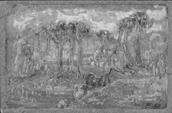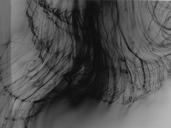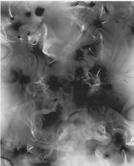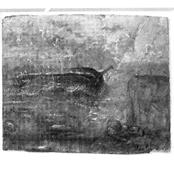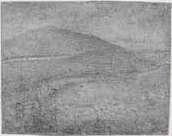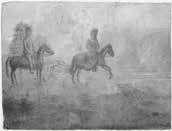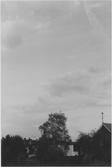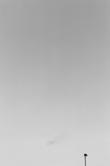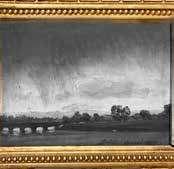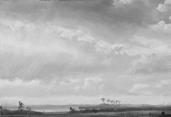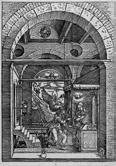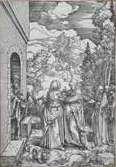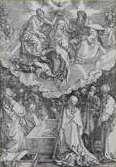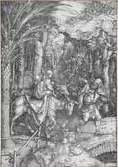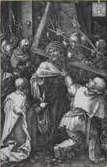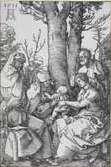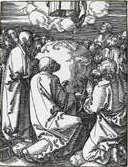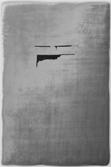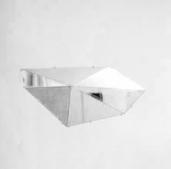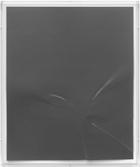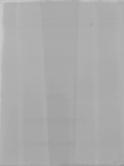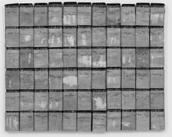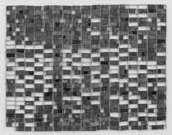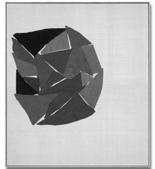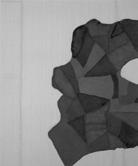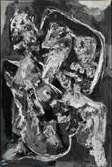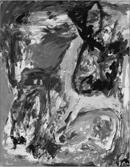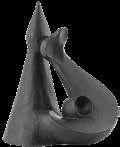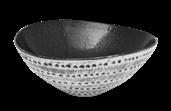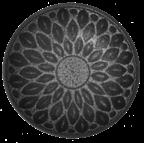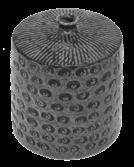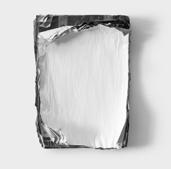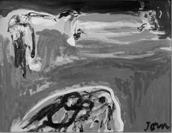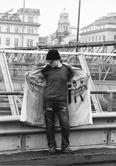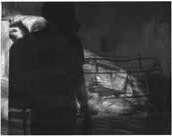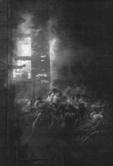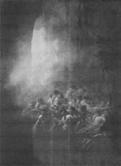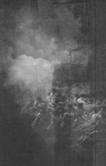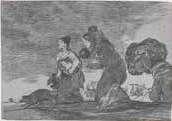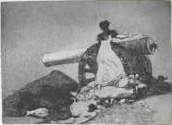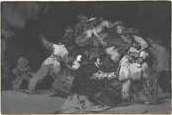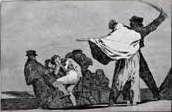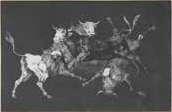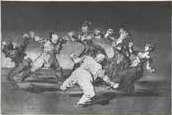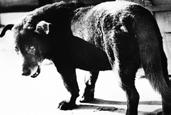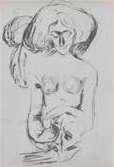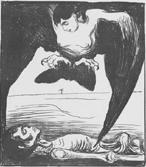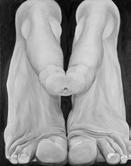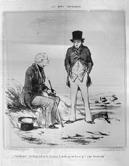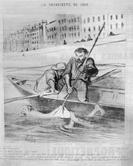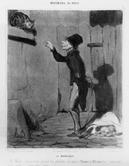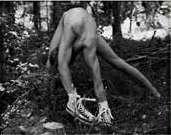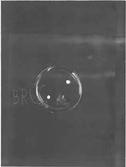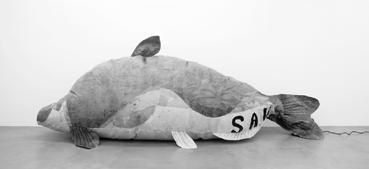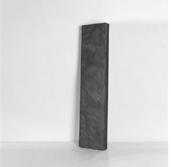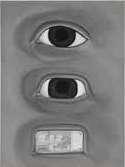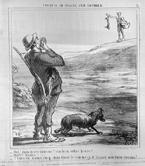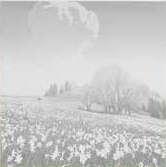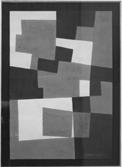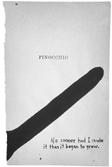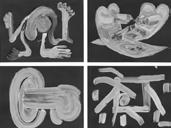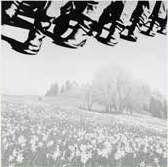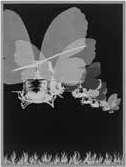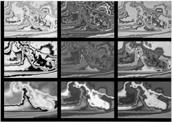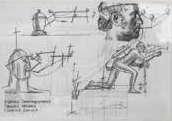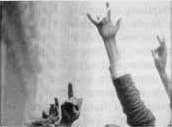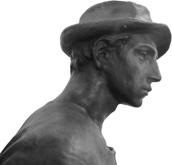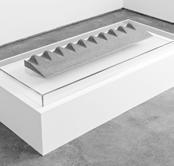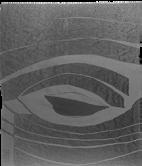Ludwig Wittgenstein noted in his treatise On Certainty that “there are an enormous number of general empirical propositions that count as certain for us. One such is that if someone’s arm is cut off, it will not grow again.” The philosopher believed this as a “truism” and one drawn from witnessing his older brother, the pianist Paul Wittgenstein, suffer through a debilitating injury. Less than one month after the start of World War I, Paul Wittgenstein was shot while assigned as junior officer in the Austro-Hungarian army while serving on the Austrian eastern front in Galicia on a reconnaissance mission. His right elbow shattered by a bullet, the concert pianist’s arm was amputated in a Russian field hospital in Ukraine, after which he was deported to an invalid ward within a Siberian prison camp in Omsk. While interned there, Wittgenstein strove to retrain and strengthen his left hand. With a piece of charcoal, he drew the outline of a piano keyboard on a wooden crate and practiced obsessively by tapping out the most complex Chopin pieces seven hours a day. Regarding this arduous rehabilitation, he later notes, “it was like climbing a mountain. If you can’t get up one way, you try another.” Eventually repatriated by means of a prisoner exchange program, Wittgenstein persevered with his efforts to perform as a concert pianist combining pedalling and hand movement techniques previously regarded as impossible for a five fingered pianist. Though his hand would not fully recover from his injury, his aptitude as a pianist allowed him to replicate the effects of ambidexterity with just the right hand. In 1915, he debuted an “able bodied” Concert Piece in the form of Variations for the Pianoforte Left Hand in Vienna, with a performance that resounded in dissolving the gap between apparent ability and disability to give the impression, according to critics, that four hands were covering the keyboard. Supported by the Wittgenstein family fortune, he continued to commission leading composers of the time –Richard Strauss, Sergei Prokofiev, and Benjamin Britten – to write new works for piano that required the use of the left hand alone. It was Maurice Ravel who composed Piano Concerto for the Left Hand as the most virtuosic among these, and it remains something of a rite of passage for two-handed players.
Wittgenstein’s single-handed address of “twohandedness” negotiated the complex demands of a musical score to surpass corporeal finitude and to
envision how a work of art may be expressed beyond the limits of its formal construction and internal logic of organization. Piano Concerto for the Left Hand serves to inspire Composition for the Left Hand as the title for an exhibition that plays and unfolds as a dialogue, an entanglement, perhaps even mutual mumbles, between two collections–one historical in content and built by the collector Rasmus Meyer (a Norwegian industrialist and committed “garden architect”) in conversation with a contemporary art collection built by Erling Kagge, a Polar explorer and writer on the subjects of silence, walking, and the durational. Each collection is situated on either end of a century and across a timeline whereby art has emerged in accordance with dramatic spatial and temporal paradigm shifts.
As a series of sequences and accents, the exhibition is composed as a working draft reflecting on what the writer Ursula LeGuin prefaces in her Left Hand of Darkness, as an “experiment wherein thought and intuition can move freely within the bounds set only by the terms of the experiment.” It is also a project that respects the contradiction inherent in the author/ artist who sets out on a committed trajectory within the stranglehold of techne: “I talk about the gods; I am an atheist. But I am an artist too, and therefore a liar. Distrust everything I say. I am telling the truth. The only truth I can understand or express is, logically defined, a lie. Psychologically defined, a symbol. Aesthetically defined, a metaphor.”
Although the exhibition privileges the left-handed in its association with intuition, eternity and mysticism, and as epitomized by art, it does so by leaning the left over its counterpart, as the right-handed is aligned with the linear flow of history, as epitomized by science. This is not intended as a dialectical exercise of oppositions–between the awkward on one side, and the logical, taut, and moral on the other. Instead, the project follows the way the brain is wired to respect how its left and its right sides work symbiotically to address complimentary modes of consciousness. In this way, left-handedness stands as a way, as Jerome Bruner notes in On Knowing: Essays for the Left Hand–to imagine how “the left hand may tempt the right hand to draw freshly again when the task is to find a means of imparting new life to a hand that has become all too stiff with technique.”
Composition for the Left Hand is an exhibition that takes the form of a manuscript that evolves by interweaving the historical works of art from the collections of Rasmus Meyer and Kode together with works from the contemporary collection of the polar explorer Erling Kagge. Unpacking My Library , the 1931 essay by Walter Benjamin serves as a valid reference in addressing the deep dive required to explore each of these vast collections, and to find the threads and constellations for a series of shared conversations and debates in their being reassembled for the sake of an exhibition. Benjamin speaks to the voracity with which one begins to unpack and the difficulty with which one may stop this activity. Taking Benjamin’s lead in that any collection is as relevant as its parts and the relevance of those works as they stand through time and history, the motivation of this exhibition was to draw selected works from their inert repository and to bring historical works of art in correspondence with the contemporary works from the Kagge Collection to illuminate their role in helping us to understand the relevance of the wider realm of their production. As Benjamin reminds us in his essay –collecting involves desire and that that although “every passion borders on the chaotic, the collector’s passion borders on the chaos of memories.” More than that, Benjamin, adds that the chance and fate that suffuse the past before his eyes are conspicuously present in the accustomed confusion of these the works. He asks – “for what else is this collection but a disorder to which habit has accommodated itself to such an extent that it can appear as order?”
In reconciling two very different trajectories - one in researching historical works in storage and how they might regain meaning or rather, convey meaning in being in proximity to other works, with whom they had never intended to be in dialogue with. In this sense, the exhibition is built out with the intention to be necessarily a cacophonic and dissonant composition. In understanding packing and unpacking as two separate processes, Benjamin emphasizes that each serve as two sides of the same impulse, marked by chaos at each pole, whereby meaning is gained from dismantlement, in the dissolution of set narratives, and in the reassembling and putting back together that may offer new encounters of interpretation and a revision of perspective. Benjamin denotes this very process as that which defines the “existence of a collector, as someone dialectically pulled between the poles of disorder and order.”
The presentation of historical works adjacent to those from the recent decades attempts to put side to side an address of the world according to the time in which the respective artists lived and live, how they pictured/ picture their environment and the cultural and political changes of their time, and how these artists attempted to intervene within the constraints of their institutional frameworks and immediate surroundings by combining depiction and narrative with the vernacular, while embracing the role of the artist as a modern, selfreflective subject.
The active pulling of works out of storage, the reviewing, the reshuffling, the conservation required for its reanimation, the lifting of objects from repose together with the embodied memories to be recast and reencountered anew, involves a complex process that is messy, untidy, unruly, provocative, exploratory, for the purpose of setting up new correlations, perhaps postulates, via revised adjacencies. Hence, Composition for the Left Hand offers the challenge proposed by Benjamin nearly a century ago anew - to “join (me) in the disorder of crates that have been wrenched open…to join (me) among the piles of volumes that are seeing the daylight again….to provide insight into collecting rather than on a collection.”
Rasmus Meyer Ground FloorLawrence Weiner
A curatorial note of memory. When I arrived as in Norway in 2005 to curate an exhibition at Kunstnernes Hus in Oslo entitled Draft Deceit, Lawrence Weiner and his critical compatriot partner, Alice Weiner came to Oslo to spend some time at Ekely during what had been a very snowy winter. Throughout the installation, there was ample time for conversations and banter. I spoke to my questioning in how to enter my position as Director of OCA, in deciding what project to start with – as not a one-off exhibition but a multiyear project that might be relevant for Norwegians, within Norway, across Scandinavia, but which also linked to the country and the region to the world. As someone who has always opened the exhibition process to social and political coordinates, I became perplexed by Scandinavia’s legacy as a hotbed of liberation and free love throughout the 1970s, because it certainly didn’t seem to be that way at the time I lived there. Lawrence Weiner suggested that I watch Vilgot Sjöman’s I Am Curious Yellow. Although a film by a Swedish director and, according to Sjöman, a film about Sweden throughout the 1960s, it opened an entire field of research that led me explore Norway’s complex history with regard to feminism, labor movements, and leftist politics. It led me to understanding it as a haven for experimental radicals such as Wilhelm Reich at a time when he was most prolific, and it led me to curating Whatever Happenned to Sex in Scandinavia? Lawrence Weiner commences the exhibition with a work in the institution’s bathroom – this as Erling Kagge, who has provided the works throughout this exhibition, choses to exhibit the vast collection of Lawrence Weiner in the entry bathroom within the Arne Kosmo villa, where he lives in Oslo. Erling reminded me of an instance when, years ago, he was visited by Weiner, who used the lavatory and upon returning stated bluntly (as he usually would), “finally, some art I can jerk off to.”
A pioneer in the Conceptual art movement, Weiner viewed language as his primary medium as a way to redefine the status of the artist and challenge, still in the 1960s, what constituted a work of art. By using language as his material, Weiner classified his work as sculpture that shared ground with philosophy, linguistics, anti-capitalist politics and poetry. Each work referred to Weiner’s generic description of their content – LANGUAGE + THE MATERIALS REFERRED TO – and his position that language itself

USE ENOUGH TO MAKE IT SMOOTH ENOUGH ASSUMING A FUNCTION
, 1999
Language + the materials referred to Lawrence Weiner (1942–2021)
Erling Kagge Collection
is three-dimensional, that the work is what it says it is. His work sought to transcend the restraints of any particular culture and context, leaving it open to the individual’s intellectual as a ‘receiver’, to read the work. In doing so, Weiner understood his work ever present, ever in flux and never ever finished. His mode of address offered a radical redefinition of the relationship between the work of art and the receiver, emphasizing this collaborative engagement that was completed by the viewer’s assimilation of their own experience.
The Rasmus Meyer Collection frames work from a kaleidoscopic historical period of social change, the late 19th to early 20th centuries – a period accompanied by spatial and temporal paradigmatic shifts that contributed to the dizzying experience of modernity – with its intellectual controversies, the introduction of psychoanalysis, its social revolutions, the formation of states, the fervor of early feminism and early labor movements, and the critical study of political economy, which would render explicit those contradictions inherent within the capitalist mode of production. The fin-de-siecle introduced modernity as, according to Charles Baudelaire wrote, “the transitory, the fugitive, the contingent, the half of art, of which the other half is the eternal and the immutable.” In revisiting the collection, Nature is deemed historical –not only because it evolves and constantly changes, but because it has been profoundly, often negatively, affected by human history. Natural history reveals a dynamic and often catastrophic interaction between the planet and human history. Correlating contemporary works collected by a polar explorer and writer on subjects such as walking and silence with the historical works with works collected by an industrialist, albeit avid garden architect casts a conversation about how art is a synthesis of the political, social and economic rooted in nature (as art) and part of an enlarged field called the environment. 1

Iceberg , 2004
Mark Handforth (1969–)
Aluminum, reflective vinyl and paint
Erling Kagge Collection
Mark Handforth
According to the pack of philosophers – Plato, Aristotle, Leibniz, Kant, Hegel, and extending to teachings of Indian, Chinese, and Japanese aesthetics –beauty was conceived as something harmonious, an organic whole and an object of pleasure. Edmund Burke worked out the concept more fully in the 18th century – suggesting that mathematical proportion, usefulness, and perfection were not the attributes of beauty and the philosophers thereafter agreed that whatever pleasure arising out of the contemplation of beauty was a different experience that arising out of erotic or sexual pleasure and interest. Immanuel Kant proposed “uninterested pleasure” in that the judgement of something as beautiful does not arrive on whether it is agreeable or pleasurable or liked. And it was Theodor Adorno who swept the category under the rug altogether and evolved the category of the ugly to resist art’s ascension into the culture industry and into commercialization. He wrote: “the impression of ugliness stems from the principle of violence and destruction. The aims posited are unreconciled with what nature, however mediated it may be, wants to say on its own. In technique, violence toward nature is not reflected in artistic portrayal, but it is immediately apparent.” The term Adorno negotiated, “cultural landscape,” would be a model whereby ugliness “would vanish if the relation of the individual to nature renounced its repressive character, which perpectuates rather than being perpetuated by – the repression of the [individual].”
That particular objects and practices are not recognized by exhibiting institutions beyond their thingness and what constitutes them as such as art, is in itself, a symptom of a system gone amok, or not gone-amok enough. It is important to take into consideration Fred Moten’s writings around the “Magic of Objects” as a way to provide insight into a series of practices articulated through race, class, gender, and sexuality as to recognize the “social capacity to render life as history – necessary for any cultural product.” In this respect, Moten calls for an imagination of a context for analysis whereby race, class, gender and sexuality as four articulating structures that would be granted historicity, politics and practice in relation to one another, and as mutually recognizable. 2
Rasmus Meyer Gift Shop and Room 112
Diamond Stingily

3
Wish You Were Here , 2008
Ceal Floyer (1968–) postcard holder
Edition 2 of 3 + 2 AP
Erling Kagge Collection

Diamond Stingily attests to having a deep encounter with Collette Thomas and The Testament of a dead Daughter, a book that has served as a profound influence for her as a writer, performer, and visual artist. Collette Thomas, one of Antonin Artaud’s “daughters of the heart,” flashed briefly before an unsuspecting Parisian literary world in 1946 to deliver a reading from Artaud’s Fragmentations. Her book was published in 1954, under the pseudonym Rene, and was comprised letters to Artaud, accounts of her early incarceration and suffering, along with tales wrenched from her tortured being. Her mental condition steadily worsened and she was to spend the rest of her life in private clinics. As an artist who weaves together personal and social memory composed of everyday objects, Collette Thomas’ diary and an anthology of poems, Stingily’s Caption is a testimony about the cruelty of love in which the past and future are entwined, as it is a novel of death and resurrection. Stingily creates work that draws from the significance of the elephant as a mammal that communicates by touch, sight, smell and sound, and exhibits mirror self-recognition, self-awareness and cognition as demonstrated in dolphins. Excelling in long term memory with one of the largest brains in the animal kingdom, elephants’ brains hold as many cortical neurons as human’s. Matriarchy is the hub of the complex social network of elephants. The matriarch who is the eldest of the group serves as the leader of the group until death, after which her eldest daughter takes over. The elephant is also known to show concern for the dying and the dead, which supports Stingily’s interest to address death as a way to, according to the artist, “encourage to conquer your fears, so that you might as well get over that shit shat.”
Elephant Memory, a chainlink from the artist’s memories of the chainlink fences of her home town of Chicago, serves as the armature for long braids of synthetic Kanekalon hair (a signature element of her installations) – sourced from childhood memories and her mother’s doing hair for a living. Drawing from an interest to produce work that carries distinct class markers and a firm sense of place, attuned to the texture of personal memory (and the politics that underlie it). 4
Elephant Memory #2 , 2019
Diamond Stingily (1990–)
Synthetic hair, galvanised steel chain, galvanised steel hook
Erling Kagge Collection
The Eruption of the Volcano Vesuvius, 1821, is a canonical work by Johan Christian Dahl painted after his visit to Naples in 1820 having had witnessed the eruption of the volcano at Mount Vesuvius. Having painted several moonscapes before, he was compelled to continue to sketch the active volcano, ascending the mountain several times to observe the natural phenomena. His work would exemplify the Kantian category of the sublime, that within nature which elicits in the human mind alternating responses of repulsion and attraction. Dahl’s painting introduces into the exhibition a concept that the Canadian poet Anne Carson refers to as “volcano time” – as a way to address temporal plurality, to set the present condition against something ancient, something colossal and in relation to a unpredictable futurity. That is to say that being in the presence of a volcano contributes to the formation of an experience whereby the phenomena is perceived psychologically and physiologically, as lava hurdles forth with terminal velocity to dramatize the duality of the sensible experience and mental perception, modifying the former by infusing the latter with anticipation. The pastoral backdrop may remain untouched although not inevitably depending on winds gusts and internal earthly forces wherein violent and active phenomena may eventually, according to geological time evolve into an arctic glacier.
The 19th century paintings through the ground floor depict the nature as landscapes to convey the phenomenal power of waves, the fury of the storms at sea, ethereality of the clouds, the magnitude of the forests as a way to convey the experience of nature. Norwegian painters Johan Christian Dahl left Norway in order to study in Dresden – as did his pupils, Thomas Fearnley, Knud Baade, and Peder Balke – only to return to continue to depict landscapes unlike those painted by his colleague, Caspar David Friedrich. The Rasmus Meyer collection emphasizes the position of Norwegian painters in this genre also represented by works by Hans Gude, who had been based in the Dusseldorf Art Academy as an instructor of landscape painting, who commanded authority there as a teacher as did Adolph Tidemand School of Painting. Although Tidemand deferred to the genre of motifs, Gude and Dahl addressed naturalism as anchored within the realm of observable natural phenomena. Dahl attempted to transmit a naturalism of his day as real although his impression in rendering was rather a simulation of a particular realm in order to generate an atmosphere, through contemplation of nature that incorporated all the senses.



View from a Window at Quisisana , 1820
Johan Christian Dahl (1788–1857)
Oil on canvas
Kode, The Rasmus Meyer Coll.

Copy of an Italian Landscape by Jan Both , 1813
Johan Christian Dahl (1788–1857)
Oil on canvas
Kode, The Rasmus Meyer Coll.

Time , 2004
Hills near Quisisana in morning Light , 1820
Johan Christian Dahl (1788–1857)
Oil on canvas
Kode, The Rasmus Meyer Coll.

Boats on the Beach near Naple s, 1821
Johan Christian Dahl (1788–1857)
Oil on canvas
Kode, The Rasmus Meyer Coll.

Scene from Ischia , 1820
Johan Christian Dahl (1788–1857)
Oil on cardboard
Kode, The Rasmus Meyer Coll.
An Eruption of Vesuvius , 1821
Johan Christian Dahl (1788–1857)
Oil on canvas
Kode, The Rasmus Meyer Coll.

The Casa del Portinaio in the Villa Borghese , 1821
Johan Christian Dahl (1788–1857)
Oil on canvas
Kode, The Rasmus Meyer Coll.

Moon , 2003
Roe Ethridge (1969–)
C-print
Edition 2 of 5 + 2 AP
Erling Kagge Collection
Karen Kilimnik (1955–) Water soluble oil on canvas Erling Kagge CollectionKaren Kilimnik
Karen Kilimnik (1955) is an artist who produces oil that allude to the Romantic tradition and to historical allegories, although inscribed by irony and the vaguely sinister. A strident environmentalist, Kilimnik has pro duced works that connote historical landscape paintings as a reflection of her concern with the natural world, although the oceans, skies, mountains, and icebergs, are rendered in such a way as if to be captured in decisive moments, at the juncture of imminent change or danger.
The Moon
Poetically the symbol of the Moon figures into many of the works. Traditionally associated with the feminine principle, with water, particularly with the sea, and with change and growth, while its phases, natural symbols of mutability and impermanence. The early 20th century mystic Madame Blavatsky had taught that the powers associated with the moon were responsible for the division of the sexes, for generation and for emotion, while the solar powers were in conflict with them and responsible for spirit and intellect. Later W.B. Yeats wrote A Vision as a meditation on the relationships between imagination, history and the occult. In this poem published in 1925, Yeats asserts a classification in outlining the 28 phases of the moon which represent states of the human personality. Each phase is pictured as of the spokes of a Great Wheel, which is “every completed movement of thought or life,” using geometric images to construct an esoteric system. 11
Roe Ethridge
Ethridge (1969) works with picture as document –his photographs recording just what the camera sees. Inspired by the work of Richard Prince and Paul Outerbridge, Ethridge adopts the armature of commercial photography to dissolve the distinction between no discrimination, and editorial and art, between document and construct. Etheridge seizes photography’s double life in moving fluidly between art and advertising, embracing evolving forms of technology within commercial media. In pursuing this slippage, Ethridge proposes pastoral landscapes without the intention to reference the Romantic tradition of landscape. Instead, these images steer ahead by alluding to the polemics of contemporary land ownership and to the capitalist logic inscribed by the perpetual production cycles which sustain purposeful obsolescence. Although the artist focuses on objects as close-ups, Ethridge is moreover interested the

Moon , 2003–2008
Roe Ethridge (1969–)
Archival Inkjet Print Edition 2 of 5
Erling Kagge Collection

J.C. Dahl , 1821
Bertel Thorvaldsen (1770–1844)
Marble
Kode
underlying networks and circuits of hyper-managed systems of production and distribution that are clearest seen from a distance. In contrast to the earlier traditions in photography, Ethridge acknowledges the impossibility of photographic originality, leaning into the popular culture of photography in employing as tropes astro photography, motion photography, editorial and fashion photography, portraiture and landscape. He notes: “Images are redundant. I am implicating myself as part of that redundancy.”
The curator Kate Bush wrote about his series entitled the Moon , to explain that Ethridge sourced images of the moon from the roof of his home in Brooklyn, using an 8 inch Meade LX90 telescope to make original photographs of an unoriginal subject. Ethridge’s “moon” is digitally repeated, twice or more, within the frame of a single photograph – rather like the sequential chronophotographs of Muybridge or Marey – in order to suggest the trajectory of the moon’s movement across the sky. “The moon moved through the frame in a perfectly straight line.” 13–14
Cultural Landscape as a Domain
By the 19th century, the landscape of modernity was populated by steam engines, factories, railroads, and cities transformed rapidly by industrialization. The widened distribution of print media – daily newspapers, telegraphs – and eventually telephones sustained larger networks of communication within mass social movements. Composition for the Left Hand seeks a dialogue with the collection’s works from the 19th century to underscore how the nature of that time has been eroded by pollution, toxins, and by the century long effects of climate change exacerbated by human negligence, avarice and militarization. As Walter Benjamin wrote in the aftermath of first world war, “human multitudes, gases, electrical forces were hurled in the open country, high frequency currents coursed through landscape, new constellations rose in the sky, aerial space and ocean depths thundered with propellers, and everywhere sacrificial shafts dug into Mother Earth. This immense wooing of the cosmos was enacted for the first time on a planetary scale” – that is, in the spirit of technology. Yet, technology, harnessed to the capitalist imperialist purpose of mastering nature, “betrayed man and turned the bridal bed into a bloodbath.” By the early 20th century, nature entered into an enlarged domain, a hybrid of the environment and the political – a field manipulated by private interests of profit and consequently of political affiliation and political ideology.
As technology intervened to mediate nature in response to the interests of capitalist development, the 19th century experience of nature as simultaneously threatening and majestic, as envisioned by Kantian aesthetics, was enlarged into the domain referred to by Theodor Adorno as “cultural landscape”, as “an artifactitious domain that must at first seem totally opposed to natural beauty to challenge if not denounce environment merely as a depiction.”
Torbjørn Rødland
The 19th century brought forth an interest in animal studies with the introduction of Charles Darwin’s Origin of the Species in 1859. This instantiated an indissoluble link to the natural world that would later be accompanied by a humanitarian address of animals and animal reform. As scientific inquiry advanced, animals became incorporated as objects to be investigated to learn more about the human body, its actions, illnesses, and pathologies. Animal behaviour lent more to the understanding about human behaviour and eventually, to an exploitative animal experimentation, genetic engineering, dog breeding and training, beyond the traditional hunting of animals for food and hunting. 32



The Elbe in Moonlight , 1841
Johan Christian Dahl (1788–1857)
Oil on canvas
Kode, The Rasmus Meyer Coll.

Breakers with the Top of a Mast and Tackle , undated
Johan Christian Dahl (1788–1857)
Oil on canvas
Kode, The Rasmus Meyer Coll.

Dresden by Moonlight , 1843
Johan Christian Dahl (1788–1857)
Oil on canvas
Kode, The Rasmus Meyer Coll.
Fjord at Sunset , 1850
Johan Christian Dahl (1788–1857)
Oil on canvas mounted on wooden board
Kode, The Rasmus Meyer Coll.

Shipwreck on the Coast between Larvik and Fredriksvern , 1846
Johan Christian Dahl (1788–1857)
Oil on canvas
Kode, The Rasmus Meyer Coll.

View of a Birch Tree in Hallingdal , 1845
Johan Christian Dahl (1788–1857)
Oil on canvas
Kode
Shipwreck on the Coast of Norway , 1830
Johan Christian Dahl (1788–1857)
Oil on canvas Kode

No Title (We grow them) , 2005
Raymond Pettibon (1957–) pencil and ink on paper Erling Kagge Collection

Mountains on Hardangervidda at Sunset , 1840
Johan Christian Dahl (1788–1857)
Oil on canvas
Kode, The Rasmus Meyer Coll.
Rasmus Meyer Room 109

View from Stalheim over Nærøydalen , 1836
Johan Christian Dahl (1788–1857)
Oil on canvas
Kode, The Rasmus Meyer Coll.

River between steep Rocks , 1825
Johan Christian Dahl (1788–1857)
Oil on cardboard
Kode, The Rasmus Meyer Coll.

Birch Tree in a Storm , 1849
Johan Christian Dahl (1788–1857)
Oil on canvas Kode

Rabenauer Grund , 1836
Johan Christian Dahl (1788-1857)
Oil on cardboard
Kode, The Rasmus Meyer Coll.
The Beast and the Sovereign was written by Jacques Derrida as two volumes, a natural history which considers the living being with the treatment of the so-called animal life in all ot its registers – his own motivation to organize into logic the submission of the beast and the living being to political sovereignty. Derrida explores the contradictory appearance of animals in political discourse, where at times, the political subject and the sovereign state appear in the form of the animal, and at other times, superior to animals. According to Derrida, “Just where the animal realm is so often opposed to the human realm as the realm of the non-political to the realm of the political, and just where it has seemed possible to define man as a political animal or living being, a living being that is, on top of that, a political being, there too the essence of the political, in particular the state and sovereignty, has often been represented in the formless form of

Forest Stream , 1825
Johan Christian Dahl (1788–1857)
Oil on canvas Kode, The Rasmus Meyer Collection

Untitled (Illness) , 2005
Torbjørn Rødland (1970–)
C-print on Fuji Crystal Archive paper mounted on aluminium Edition 2 / 3 + 1AP
Erling Kagge Collection

Pork said the Bear , 1900–10
Theodor Kittelsen (1857–1914)
Oil on cardboard Kode


The lower Falls at Trollhättan , 1826
Johan Christian Dahl (1788–1857)
Oil on canvas
Kode, The Rasmus Meyer Coll.

River between steep Rocks , 1825
Johan Christian Dahl (1788–1857)
Oil on canvas
Kode, The Rasmus Meyer Coll.

Puppy , 2010
Lutz Bacher (1943–2019)
Painted plaster and metal, circular glass top
Erling Kagge Collection
Rocky Coast near Bergen , 1834
Johan Christian Dahl (1788–1857)
Oil on canvas
Kode, The Rasmus Meyer Coll.

Coastal Landscape at Sunset, 1819
Johan Christian Dahl (1788–1857)
Oil on canvas
Kode, The Rasmus Meyer Coll.

Study of two Calves , 1830
Johan Christian Dahl (1788-1857)
Oil on cardboard
Kode, The Rasmus Meyer Coll.
animal monstrosity, in the figure without a figure of a mythological, fabulous and non-natural monstrosity, an artificial monstrosity of the animal.”
Derrida notes several specific animals as their anthropomorphic figure within fables. The wolf, he notes, be it in fantasy, narrative, fable or in rhetorical treatment, serves as the animal that is most referred to in relations to questions of animal and the political, of the politics of animal, of human and beast in the context of the polis and the social body. But Derrida also emphasizes that it is the she-wolf that is the symbol of sexuality and sexual debauchery. The monkey - inpenetrable in terms of communication,the dolphin – intelligent as humans, and the elephant – as the phenomenal beast who is both the subject and the object of the gaze of the Sun King, a ≈ king of light and source of light. 32, 145
Theodor Kittelsen
Theodor Kittelsen’s formal education as an artist was hindered by economic hardships although the patronage from a wealthy townsperson allowed him to attend Wilhelm von Hanno’s drawing school and the Royal College of Art and Design in Oslo. He proceeded to continue his studies in Munich together with Erik Werenskiold, Christian Skredsvig and Eilif Peterssen although his professional success as an artist was hindered by his departure from the standards for Realism in the day. As he struggled to support himself as an artist, he was eventually hired to illustrate folk tales for an Oslo zoologist P. Chr. Asbjørnsen – a productive professional engagement that continued for 30 years. It was in this period, that Kittelsen had illustrated fairy tales and trolls, as appearing in his 1899 classic edition of Norwegian Folktales. In addition to this work, he continued to paint and to produce lyrical prose with drawings that were published in Fra Lofoten (1890), Fra Lofoten II (1891), and Troldskap (1892).
35, 43–46, 48–49



38
Bear lying on its back , 1825
Johan Christian Dahl (1788–1857)
Oil on cardboard

Two German Sheperd Dogs , 1827
Johan Christian Dahl (1788–1857)
Oil on paper mounted on cardboard
Kode, The Rasmus Meyer Collection

44
Croak! Croak! , 1907
Illustration for Trangsviks posten , Vol. 3, No. 15
Theodor Kittelsen (1857–1914)
Pen on paper
Kode, The Rasmus Meyer Coll.
Donkey with a Chair-saddle , 1820
Johan Christian Dahl (1788–1857)
Oil on cardboard
Kode, The Rasmus Meyer Coll.

Wolf , 1828
Johan Christian Dahl (1788–1857)
Oil on canvas
Kode, The Rasmus Meyer Coll.

The Little Elephant , undated Theodor Kittelsen (1857–1914)
Pen on paper
Kode, The Rasmus Meyer Coll.
Two Salmon , 1844
Johan Christian Dahl (1788–1857)
Oil on cardboard
Kode, The Rasmus Meyer Coll.

A Wreck , 1900–1907
Illustration for Trangsviks posten , Vol. 3, No. 6
Theodor Kittelsen (1857–1914)
Pen on paper
Kode, The Rasmus Meyer Coll.

40 46
Aeolian Harp , 1905
Theodor Kittelsen (1857–1914)
Olje på lerret Kode
In the Lion, s Den
John Savio
John Savio was born in 1902 into a Sami family – his father participated in the South Pole expedition. Upon the death of his parent, he had been raised by grandparents who were wealthy traders, reindeer owners and fisherman, that supported Savio’s middle education in Vardø where he became acquainted with the Sami member of parliament Isak Saba who became his teacher. Savio continued his education in Oslo where he attended the Norwegian National Academy of Craft and Art Industry. Throughout the 1920s, Savio travelled extensively throughout Norway to places like Karasjok, Lofoten, and Romsdal, although with meager means. In order to support himself, he traveled door-to-door selling his woodcuts of Sami folklore and cultural imagery. He continued to travel into Europe with exhibitions in Paris in 1936 where he received critical praise, although he died impoverished.
Traditional Sami spiritual practices and beliefs are tied to animism and the belief that connecting to the enrionment therein would produce great spiritual benefits. Under this framework, all bodies, human, animal or otherwise, are animated by a spiritual component or soul, which is endowed with intentionality.
Throughout the 17th century, Sami individuals were burned at the stake for practicing witchcraft in shamanistic traditions in using drums and practicing sacrificial rituals related to healing, fortune telling, finding lost objects, the absolution of sins, and
Rasmus Meyer Room 108 Rasmus Meyer Room 107
Standing Clock, Régence Oak with intarsia
Kode, Rasmus Meyer Coll.

The Contemporary Bird Eben Selbius, who Sings with Others’ Beaks , 1912
Theodor Kittelsen (1857–1914)
Pen on paper
Kode, The Rasmus Meyer Coll.

Taj Bag , 2008
Roe Ethridge (1969–)
C-print
Edition 1 of 5 + 2 AP
Erling Kagge Collection

Mister Rheder Jørnsen and the Spitting Lama , 1900-07
Theodor Kittelsen (1857-1914)
Pen on paper
Kode, The Rasmus Meyer Coll.

Two Cousins , 1912
Theodor Kittelsen (1857-1914)
Pen on paper
Kode, The Rasmus Meyer Coll.

Big Cock 1 , 2020
Heji Shin (1976–)
Inkjet print
Edition 1 of 3 + 2 AP
Erling Kagge Collection

Cormorants on Utrøst , 1912
Theodor Kittelsen (1857–1914)
Pen on paper
Kode, The Rasmus Meyer Coll.

Untitled , 2008
Lari Pittman (1952–)
Del vinyl and aerosol enamel on canvas over wood panel
Erling Kagge Collection

Al Dente , 2003
Isa Genzken
Italien ceramic, lacquer, plastic.
Edition 41 of 74
Erling Kagge Collection

weather magic. Attempts at effacing these practices from the country continued through the early part of the 19th century, when Norway adopted policies to dislocate the Sami minority population, involving forced assimilation and language policies. Throughout the 1920s, if anyone wanted to buy or lease state lands for agriculture in Finnmark, families had to be fluent in the Norwegian language and due to schooling requirements schooling, many families had to abandon a traditional and nomadic way of life. 56–64
Woodcut Kode


Confirmands
( Rihppaskuvllas) , undated John Savio (1902–1938)
Woodcut
Kode
The Cult of Ruin
Woodcut Kode
Within the cultural landscape, nature is doubly and paradoxically connotative of both the dominant and the dominated. Adorno tells us that this conflict of meaning resides by a disenchantment with the world, constituted by an impulse, a motivation, a longing, an insistence. With the collapse of romanticism and the rampant introduction of industrialized capitalism, natural beauty becomes merely an image, as exemplified by now-kitsch icons, Matterhorn and purple heather: “natural beauty, in the age of its total mediatedness, is transformed into a caricature of itself.” With the stronghold of organized tourism, it is telling that in the 1960s, Adorno foresaw that a feeling for nature was starting to amount to a “moralistic narcisstic posturing
Lollipop (Soaddenjálggis) , undated John Savio (1902–1938) Girl (Nieida) , undated John Savio (1902–1938) Rasmus Meyer Room 106 61 59 60

Boys with lasso Gaudak suopanin (Gutter med lasso), undated
John Savio (1902–1938)
Woodcut Kode

Good weather (Shiega dolke) , undated
John Savio (1902–1938)
Woodcut Kode

Nærøy Fjord , 1834
Knud Baade (1808–1879)
Oil on cardboard Kode, The Rasmus Meyer Coll.
Wolf Pair (Gumpe guoktas) , undated
John Savio (1902–1938)
Woodcut Kode

Lasso (Suopan) , undated
John Savio (1902–1938)
Woodcut Kode

Coffee Break (Káfe vuoššá) , undated
John Savio (1902–1938)
Woodcut Kode

Wolf and reindeer (Gumppet ja bohccot) , undated
John Savio (1902–1938)
Woodcut Kode

Moonlight , 1869
Knud Baade (1808–1879)
Oil on canvas Kode, The Rasmus Meyer Coll.

Rockaway (Spring‚ 08) , 2008
Roe Ethridge (1969–)
C-print
Edition 3 of 5 + 2 AP
Erling Kagge Collection
as if to say: What a fine person I must be to enjoy myself with such gratitude – then the very next step is a ready response to such testimonies of impoverished experience as appear in ads with personal columns that claim sensitivity to everything beautiful.”
In conclusion: “the essence of the experience of nature is deformed.”
Lars Hertervig
Hertervig had been born into poverty, his family adhering to Quaker traditions that valued essentialism and the pursuit of inner light. The Norwegian architectural theorist Christian Norberg-Schulz provides further insight with respect to this idea of light as specific to the Norwegian context: “the Norwegian term for weather (vær) is related to være (to be). ‘To be’ signifies being thrown into a changing and unpredictable world, i.e., a world that provides no fixed point of view, a world in which we are unable to accept the given and act freely.” 68–69, 74



Seascape , undated
Lars Hertervig (1830–1902)
Oil on canvas Kode

Forest Landscape , 1830
Thomas Fearnley (1802–1842)
Oil on cardboard
Kode, The Rasmus Meyer Coll.

Mountain Lake, undated
Lars Hertervig (1830–1902)
Oil on canvas Kode
Landscape with a church
Lars Hertervig (1830–1902)
Oil on canvas Kode

The Gulf of Sorrento , 1834
Thomas Fearnley (1802-1842)
Oil on cardboard
Kode, The Rasmus Meyer Coll.

Grindelwald , 1835
Thomas Fearnley (1802–1842)
Oil on canvas Kode, The Rasmus Meyer Coll.
Königssee in Bavaria , 1830
Thomas Fearnley (1802–1842)
Oil on cardboard
Kode, The Rasmus Meyer Coll.

Monte Vesuvio , undated
Thomas Fearnley (1802–1842)
Oil on cardboard
Kode, The Rasmus Meyer Coll.
Peder Balke
Shipwreck
Peder Balke was revolutionary in the pictorial context within the context of 19th century landscape painting. His sea- and mountain-scapes were more attenuated and less lustrous than of his peers in the Romantic concept of nature. In his mature work, Balke rejected the view of nature as immense and unruly sublime, and opted instead for radically reductive, almost monochrome renderings. According to Per Kirkeby, Balke used “…an orgy of dirty tricks, worthy of any stunt painter: waves executed as marbling, sponge-dubbing, combing wet paint and whatever worked.” Kirkeby’s interpretation was not intended as critique, rather as a candid reflection upon Balke as an artist, staking out the modern by making painting transparent: “a wave is a wave, and already rolled to nothing, like so much water, and a painting is a painting.” Balke was, after all, working in the wake of an industrial age, after which trust in natural beauty had succumbed to its total mediation, in the form of pollution, exploitation, and commodification.
In this sense, Balke abandoned the meticulously executed composition and the blue and brown tones that predominated in his earlier work, to employ simpler techniques to capture light against darkness. The main forms are developed by the bold, sweeping movements of rags, course brushes, and even with his own fingers. His fingerprint is left as a mark that makes the artist’s process and presence transparent.
Balke’s unconventional techniques led contemporary critics to hold him in contempt. A review in Morgenbladet described the work at the time as:
“…devoid of all artistic interest – his paintings with terrible colors, just black and white and few garish touches of blue and yellow here and there, with no
Rasmus Meyer 105


Tree Lamp , 2020
Urara Tsuchiya (1979–)
Glazed stoneware Erling Kagge Collection

View across Fjord , 1859
Hans Gude (1825–1903)
Oil on canvas
Kode, The Rasmus Meyer Coll.

Eidsvoll Church , 1855
Joachim Frich (1810–1858)
Oil on canvas
Kode, The Rasmus Meyer Coll.
Chest of drawers, Empire Mahogany with intarsia Kode, The Rasmus Meyer Coll.

Waterfall , 1856
Gustav Adolph Mordt (1826–1856)
Oil on paper mounted on cardboard
Kode, The Rasmus Meyer Coll.

Welsh Landscape , 1864
Hans Gude (1825–1903)
Oil on canvas
Kode, The Rasmus Meyer Coll.
Table clock, classicism Bronze Kode, The Rasmus Meyer Coll.

Dying Trees , undated August Cappelen (1827–1852)
Oil on cardboard
Kode, The Rasmus Meyer Coll.

Bodensee, Bavaria , 1882
Hans Gude (1825–1903)
Oil on canvas
Kode, The Rasmus Meyer Coll.
question of a grandiose, poetic perception; not even in the simplest technical requirements of drawing, perspective, clarity, strength, and depth of color have been observed. The fore and middle grounds appear to have been drawn with a ruler…”
Born on the island of Helgøya in Ringsaker in 1804, Balke was raised in a humble family, and developed a clear awareness of the disparity between social classes. Throughout his life, he was drawn towards the political, economic, and social realities of his time. Art provided him with the means to live a life free from servitude to the state. His compositional technique remained unusual for his time, and this eccentricity, coupled with his increasing activist role in the pursuit of workers’ rights, complicated reception of his work. He became the Chairman of the Workers’ Union in the 1850s, and was regarded as a radical idealist, set on improving the material and institutional conditions of the workplace. When he died, his obituary credited him as a socially aware and committed citizen.
Peder Balke went so far as to abandon the brush substituting his finger blending black and white pigment so as abandon color and grand scale, in feigning nature, to abstractly and reductively, attempt to convey its true force. 90
Richard Prince Cowboy
Richard Prince (1949) manipulates means and products of mass media from the American advertising culture of the late 1970s. During the 1970s and as an aspiring painter, Prince worked in the tear sheet department at Time-Life Inc.in Manhattan, helping to oversee several separate magazines. While there, Prince began to rephotograph those pages, often cropping the shots to obscure text or logos, intensifying their artifice. In doing so, Prince undermined the seeming naturalness of the images, revealing society’s desires as hallucinatory. Untitled (Cowboy) among his most renowned series as a deconstruction of an American archetype at a time, as profiled in the 1960s ad campaigns for Marlboro cigarettes. Prince’s Cowboy conjures another illusion, one specifically associated with the excesses of the 1980s and the conflation of materialism and nature as manifested by spectacle. That decade in America was defined by President Ronald Reagan who promoted neoliberal policies which largely benefitted the wealthy. A former Hollywood actor, Ronald Reagan was stage managed, acting out the role of a cowboy, appealing to a romanticized notion of masculine authority. 85

Untitled (Cowboy) , 2003
Richard Prince (1949–)
Ektacolor photograph
Edition 2 of 2 + 1 AP
Erling Kagge Collection

Mountain Landscape , 1892
Hans Gude (1825–1903)
Oil on canvas Kode, The Rasmus Meyer Coll.

From Asker , undated
Hans Gude (1825–1903)
Oil on canvas Kode, The Rasmus Meyer Coll.

Forest Interior , 1873
Hans Gude (1825–1903)
Oil on canvas Kode

View from Bøverdalen , 1868
Johan Fredrik Eckersberg (1822–1870)
Oil on canvas Kode, The Rasmus Meyer Coll.

Ship in Surf , undated
Peder Balke (1804–1887)
Oil on canvas Kode, The Stenersen Collection
Oscar Tuazon
Wreck
Oscar Tuazon (1975) is a sculptor who works with natural and industrial materials to create objects, structures, and installations that can be used, occupied or otherwise engaged by viewers. With an interest in deconstructivist architecture, Tuazon produces environments that reconnect humanity’s connection to habitat and objects that promote reflection upon the potential of architecture digressing from its allegiance to the Fordist values of global capitalism. 91
Seth Price
Mother and Child
Mother and Child is composed of yew wood, one of the oldest native tree species in Europe, and also attributed as a symbol of death and doom as it also provides shelter and food for woodland animals. It is coated with diamond acrylic plastic, a bulk industrial material used for plastic sheeting and multiple uses. Price integrates industrial plastics for a host of cultural associations, including as symbolic of modernism’s belief that technological progress may be an embodiment of the modes of production, distribution & proliferation, collapsing the distinction between the handmade/organic and the massproduced. 92
Klara Lidén
Paralyzed
Klara Lidén’s Paralyzed, an uninhibited dance performed on the metro in Sweden, reflects futility as a pervasive condition of contemporary life. Helen Molesworth has written of the work that Liden is doing damage to her own property, rather than to other people’s, and that in doing so she is doubtlessly making her daily life just ever so slightly more difficult.” The soundtrack in Lidén’s film is Paralyzed, by Legendary Stardust Cowboy, an outsider to be a musician who considered to be incapable of playing an instrument, singing in tune, or keeping in time. Released in 1966, the song was considered unintelligible, even said to be one of the worst songs ever recorded. Despite this labeling, the song made “the Ledge” a cult figure. In 1973, a team of NASA Mission Control technicians picked the song to wake up members of the astronauts aboard the Skylab space station, who, in turn, found the song so disruptive that they forbade it from ever being played again on any mission. 94

91
Wreck , 2007
Oscar Tuazon (1975)
Folded digital C-prints
Edition 2 of 2 + 1 AP
Erling Kagge Collection

94
Paralyzed , 2003
Klara Lidén (1979–)
DVD
Edition 10 of 10 + 1 AP
Erling Kagge Collection

92
Untitled (Mother and Child) , 2008
Seth Price (1973–) yew wood and diamond acrylic plastic
Erling Kagge Collection

93
From Königsee, Bavaria , 1832
Thomas Fearnley (1802-1842)
Oil on cardboard Kode, The Rasmus Meyer Coll.
Rasmus Meyer Room 104Significant Others
Gerhard Munthe
Sigrun Sandberg Munthe
Gerhard Munthe (1849–1929) was a landscape painter who played a pivotal role in the 19th century revival of pictorial tapestry in Norway. Bewitchment – the transformation of one world to the other – was a common theme both in folk tales at the time and in Munthe’s tapestries. From the 1890s into the 1920s, Gerhard Munthe designed many weavings with images of underworld creatures and scenes of people being bewitched. However, it was in 1888, that Munthe designed his first tapestry for his wife Sigrun Sandberg to weave. Sigrun Sandberg Munthe (1869–1957) was inspired by traditional weavings that she saw in farmhouses in the countryside where Gerhard had been painting and she continued to weave many of his watercolors into designs including Three Princesses (1905). The theme for the tapestry may be a reference to The Three Princesses in the Blue Mountain - a tale which begins with three sisters, normally kept inside the castle walls for their protection, successfully pleading with the guard to let them into the garden. They collect beautiful flowers in the afternoon sun, but after picking a large rose are swept away on a snowdrift. There were other weavers who realized Munthe’s designs including Augusta Christensen, the head of the weaving school at the National Museum for Art and Design in Trondheim, and the first weaver after Sigrun Sandberg to translate Munthe’s watercolors into woven wall hangings. Later tapestries had been woven also by Ragna Breivik.
95–96, 99, 101, 175



97 95
From Elverum , 1879–80
Gerhard Munthe (1849–1929)
Oil on canvas
Kode, The Rasmus Meyer Coll.

98
Landscape with cattle , 1870
Anders Askevold
Oil on canvas Kode, The Rasmus Meyer Coll.

The Proposal , 1873
Gerhard Munthe (1849–1929)
Oil on canvas
Kode, The Rasmus Meyer Coll.
96
The artist‘s home in Elverum , 1880
Gerhard Munthe (1849–1929)
Oil on canvas Kode, The Rasmus Meyer Coll.

99
The Fairy Garden , c. 1894
Gerhard Munthe (1849–1929) and Sigrun Munthe (1869–1957)
Tapestry, wool Kode
Study Head, An Italian , 1842
Adolph Tidemand
Oil on canvas
Kode, The Rasmus Meyer Coll.

100
Rock and Heather , 1862
Anders Askevold (1834–1900)
Oil on cardboard
Kode, The Rasmus Meyer Coll.
101 Rasmus Meyer Room 103Isabella Ducrot (1931) is an artist devoted to woven cloth as the founding material of her artistic practice. Earlier in her artistic career, Ducrot assembled a collection of antique textiles from her travels to Asia, primarily from Turkey, India, China, Tibet and Afghanistan. Her first source of inspiration comes from the weft of these fabrics, with the aim to reveal the original architecture of the material, composed of crossing threads and voids. Works like Tendernesses portray godlike figures inspired by Persian miniatures, or Pots, still life arrangements made on parchment like sheets of handmade paper and thin cotton, to reflect the artist’s enduring interest in pattern, and in the capacity for memory and narrative to be refracted into schematic form – ‘rewoven’, that is, via an array of repeating marks and motifs. 103, 105, 212
Ann Cathrin November Høibo follows a simple pattern of warp-and-weft in weavings are part of a lineage of textile art within her native Norway. Mentored by Else Marie Jakobsen, the pupil of Hannah Ryggen, to Frida Hansen who established the Workshop for National Tapestry Weaving in 1892– to follow in the tradition of weaving with respect to social, political coordinates.
Prunella Clough
Prunella Clough (1919–1999) started out her career working in mapping and graphic design for UK’s Ministry of Labour before she committed to painting in the early 1940s. Among her first works to be exhibited, Equinox from 1947 designates the line in the year when the Earth’s axis is tilted neither toward nor away from the sun and also denoting a new start in astrology. It was also the year in which provisions for self-governing Pakistan and India came into existence. Throughout the 1950s and onward, Clough found subjects for her paintings in London’s industrial wastelands and bomb sites, docks, power stations, factories, and the scrapyards of the city. The painter described her forays into what she described as “collected awkward facts” as reassembled into paintings to hover between figuration and abstraction. As she noted: “art is as realistic as activity and as symbolic as fact.” 106, 134, 181

102
Staircase in the Rosendal Manor , 1903
Marcus Grønvold (1845–1929)
Oil on canvas Kode, The Rasmus Meyer Coll.

105
Small Tendernesses II , 2022
Isabella Ducrot (1931–) Collage, pencil and pigment on Japan paper
Erling Kagge Collection

108
Untitled , 2014
Ann Cathrin November Høibo (1979–) Textile Erling Kagge Collection

103
Teiera Verde IV , 2019
Isabella Ducrot (1931-) Collage, pencil and pigment on Japan paper Erling Kagge Collection

106
Equinox , 1947
Prunella Clough (1919-1999) Oil on canvas Erling Kagge Collection

104
Kitchen Interior , 1879
Frits Thaulow, (1847-1906)
Oil on canvas
Kode, The Rasmus Meyer Coll.

107
Untitled (Jar) , 2003
Wolfgang Tillmans (1968-) C-type print Erling Kagge Collection
Wolfgang Tillmans
The Body Politic
The early period of the Industrial Revolution was one which evolved the body politic – that is the body that had previously been linked to the natural (and the supernatural) became merged with political economy on various levels – a body politic that was interwoven with the social relationships of production and reproduction. Donna Haraway has written extensively around this topic in “Animal Sociology and the Body Politic, 1978.” As early capitalism evolved, the body politic became separated from natural knowledge – the body, that is, split away and increasingly alienated from the understanding of the human and the interplay of the surrounding world in the satisfaction of organic and social needs to succumb to systems of control that was embedded in the marketplace. Sex gets equated with affliction, something that is physically and psychologically stressful, damaging, what it is to bear the mark of others. Sex is pain and a somatic phenomenon. 107, 136
Christian Krohg
In the 1890s, neither Oslo nor Kristiania could be called metropolitan – rather, these were bourgeois provinces of about 135,000 inhabitants situated in among Europe’s least developed countries. In 1890, Knut Hamsum published Hunger (Sult) as a semiautobiographical chronicle of physical and psychological hunger experience by an aspiring writer in late 19th century. Marx has addressed hunger in Capital (1869) that suggested that physical want was an integral element of the labor market. The book also spoke to the collision of metropolis and mental life. Sex reform as a wider movement of social reform took hold throughout Europe at the start of the 20th century –one that reflected a public debate around equal rights for women and men, as well as for those historically marginalized on the basis of their class or sexual orientation. Norway was at the forefront of those early reforms as reflected in the more radical position on the part of the cultural community referred to as Kristiania bohemen located in contemporary Oslo. Following Henrik Ibsen’s address of such unspoken topics as venereal and sexually transmitted diseases in Ghosts (Gengangere, 1881), an emerging Norwegian literary and artist community generated wider discussions around the legalization of prostitution as proposed by the Kristiania Arbeiderforening (Kristiania Workers’ Society) in 1882. The writer Hans Jæger published the novel From the Kristiania Bohemia in 1885, a story that

109
Twelve Different Courses
Illustration for “ Trangviks posten Vol. 3, No. 16
Theodor Kittelsen (1857–1914)
Pen on paper
Kode, The Rasmus Meyer Coll.

112
Mr. Jens Træby , Illustration for “ Trangviks posten Vol. 3, No. 9, 1907
Theodor Kittelsen (1857–1914)
Pen on paper
Kode, The Rasmus Meyer Coll.

115
Wedding Procession Through the Forest , 1873
Adolph Tidemand (1814–1876)
Oil on canvas Kode, The Rasmus Meyer Coll.

110
No Title ($5000 for the) , 1983
Raymond Pettibon (1957–) pencil and ink on paper Erling Kagge Collection

113
Safe , 2006
Kirsten Pieroth (1970–) Safe tipped forward Erling Kagge Collection

116
The Devil at the Feast , undated Theodor Kittelsen (1857–1914)
Pen and pencil on paper Kode, The Rasmus Meyer Coll.

111
No Title (She made no) , 2001
Raymond Pettibon (1957–) pen and ink on paper Erling Kagge Collection

114
Operetta , 2006
Lari Pittman (1952–) Cel vinyl and aerosol enamel on gessoed canvas over panel Erling Kagge Collection

117
Struggle for Survival , 1889–90
Christian Krohg (1852–1925)
Oil on canvas Kode
recounts the experience of two young men in relation to dominant social and sexual mores of the time. The novel marked Jæger’s foray into sexual liberation and social justice. A year later, the painter Christian Krohg published Albertine, a novel that referred to prostitution as a way to tell of the greater exploitation of the lower classes by the Oslo bourgeoisie.
By 1910, the rights recognized onto women by the Norwegian state were progressive by international standards. Married women in Norway were among the first in Scandinavia to hold independent legal status, and by 1913, they gained the right to vote in national and local elections, marking Norway as the first state within Europe to do so. In this way, the pursuit of civil, social, and political rights had been inscribed into the political agendas of the Labor Parties to reflect what Herbert Marcuse would refer to as an aim to develop “a social wealth for shaping man’s world in accordance with life instincts.”
The Women’s Federation of the Labor Party (Arbeiderpartiet) had campaigned as early as 1901 for sexual reform to arrive as a key political issue build into the sovereign statehood of Norway. The movement’s key protagonists – Elise Ottesen Jensen and the feminist Katti Anker Møller, each lobbied for the emancipation of motherhood by facilitating welfare benefits for mothers and for assistance for single mothers. The political activist Henrik Berggren as part of the Norwegian Youth Socialists, was noted for Kärlek Utan Barn (Love without Children) a speech that landed him with a short prison term, and contributed to the adoption of a law that made any lobby advocating birth control illegal. Nevertheless the continued efforts of Ottesen Jensen and Anker Møller continued to lobby for the legalization of abortion so that motherhood was a voluntary choice, and to educate young women as to reproduction and birth control. Ottesen Jensen made these views public authoring a column within the Swedish newspaper, Arbetaren, that reached out to a larger community that included Käthe Kollwitz, a German artist and activist for worker’s rights in Germany. A feminist and socialist, Kollwitz was deeply influenced by August Bebel’s pioneering treatise on feminism – Woman and Socialism (Die Frau und der Sozialismus, 1879). These sociopolitical achievements on the part of the early women’s movements, and which had been part of the wider political agenda for statehood as a social democracy, were eventually challenged by a the widening rift between socialist and non-socialist women, following the Soviet revolution in 1917. The project of early feminism was also hindered further by the introduction of psychoanalysis and cinema – both disciplines imparting new perspectives in relation to interiority and in placing women, once again, in subordinate roles. 117, 161, 164, 188, 191, 193–195

118
Young Girl in the Lap of Death, from the series Death, 1934 Käthe Kollwitz (1867-1945)
Crayon lithograph
Kode, The Stenersen Collection

121
Death is recognized as Friend, from the series Death , 1937
Käthe Kollwitz (1867-1945)
Crayon lithograph
Kode, The Stenersen Collection
Käthe Kollwitz
Käthe Kollwitz was an artist who expressed a political commitment to social change that reflected the changing political landscape of her time. She gained recognition through her series, A Weaver’s Uprising (Ein Weberaufstand) in 1898 followed by The Peasants’ War (Der Bauernkrieg) series (1902–1908) which further demonstrated her commitment to the plight of the oppressed and disempowered. The Peasants’ War served as a sociopolitical pictorial manifesto that depicted strong female figures, leaders of a revolt. Kollwitz’ portrayal of women in acts of suffering, rebellion, revolution, became prominent at a time after when World War I was dramatically changing the lives of women. 118–123

119
A Mother protecting her Child against Death, 1934 Käthe Kollwitz (1867-1945)
Lithography
Kode, The Stenersen Collection

122
Woman Entrusts Herself to Death, from the series Death , 1934
Käthe Kollwitz (1867-1945)
Crayon lithograph
Kode, The Stenersen Collection

120
Death on the Road, from the series Death , 1937
Käthe Kollwitz (1867-1945)
Crayon lithograph
Kode, The Stenersen Collection

123
Death in a Crowd of Children, from the series Death , 1934
Käthe Kollwitz (1867-1945)
Lithography
Kode, The Stenersen Collection
1st Floor
Rasmus MeyerThe Norwegian philosopher Arne Næss wrote Ecology, Community and Lifestyle: A Philosophical Approach in 1977 as a treatise to connect ecological concern with self-realization to become synonymous with “deep ecology.” Næss argued for the individual to see themselves as part of nature rather than separate from it, to care for the “environmental self.” He advocated for an understanding of things in nature as part or extensions of the individual, and in positing one’s authentic being in nature as a key part of one’s selfrealization. Næss drew from two key thinkers – Erich Fromm and Baruch Spinoza. Whereas from Fromm, Næss drew the idea an authentic love and care for ourselves will inform our concern for the environment, from Spinoza, Næss culled the need to strive for self-realization, as a way to integrate environmental concern into the development of what it is to be human. For Næss, he made no distinction between those who wanted to cultivate a garden and those driven to wild places in nature. His own preferred place was a mountain hut above the timberline beneath the Hallingskarvet Mountain in central Norway –a three-hour walk from the closest train station.
Erling Kagge regards Arne Næss a teacher. Having located a stripped-down cabin on the mountain range upcoming book on the subject of the Arctic, he is reminded of the sentence that Naess iterated to him – that “philosophically there is a chasm between the impossible and the fantastically unlikely.” And if Naess proposed to Kagge that, “two plus two can equal five if something changes,” that was enough to motivate Erling to keep walking and climbing, beyond the reasonable limits of human habitation.
Although Rasmus Meyer may have been unfamiliar to the writings of Næss, he was closely connected to gardens having been trained as a gardener. He designed a large park at his summer residency at Åstveit in addition to designing a city garden in Fjellsiden, with a preference in cultivating different types of tulips. That he decided to end his life in the year of 1916 referred to his Norwegian history as “when the dead was calling” is not a story told.
In this botanical room, the two meet for the first time, as Alex and Lutz, piggybacking one atop the other within the makeshift winter garden.
Nobuyashi Araki
Flowers figure into Araki’s work as symbols of Eros and Thanatos. Having been raised nearby Jyokanji temple in downtown Tokyo, a place where spirits of courtesans from Yoshiwara were enshrined, Araki used to watch the cut flowers offered at the graveyards. To Araki, arranging decayed flowers is a form of revival, and photography records the beauty of brevity as eternal in Eros, representing the confluence of all those tendencies within us that aim to preserve life, and Thanatos, representing the impulse toward death, as central forces in human existence. 126
Frida Hansen
Frida Hansen (1855–1931) was a Norwegian artist who had been trained by prominent artists such as Kitty Kielland in private lessions. Earlier in her career, she was an avid gardener and as an artist who sourced dyes for color palettes and scents for her textiles from the flowers and plants in gardens. In the early 1870s, when she and her husband faced bankruptcy during the economic depression, she learned how to weave and in 1890, she established a thriving business in the Studio for Handwoven Norwegian Tapestries. Later, she opened the weaving studio in in Tullinløkka in Oslo in 1892 for the wider production of textiles with a team of assistants. During this time, Hansen extended the studio into a teaching platform for women in weaving so that they might learn a trade and earn a living. Her commitment to such endeavors led her to weave a large scale tapestry for the 1893 Chicago World’s Fair, entitled Løvetann (Dandelion). The tapestry, which had been commissioned by the Norwegian Association for Women’s Rights, became an important symbol for the early women’s movement in Norway and for the expression of women’s struggle against oppression. In 1897, Hansen patented a special technique for weaving transparent tapestries – wool weft for the pattern would be woven on the warp of plied wool, leaving portions of the warp unwoven and allowing light to transmit through the open thread designed for textiles as room dividers and curtains. Hansen went on to receive critical acclaim for the tapestry Melkeveien (Milky Way) at the Paris Exposition in 1900. In 1897, Hansen established the Norwegian Rug and Tapestry Workshop – later renamed The Norwegian Tapestry Studio (DNB), which would become one of the most important weaving studios in Europe. 127–128
Marc Camille Chaimowicz
Marc Camille Chamowicz (1947) explores the dissolution of boundaries between art and design and between the public and private. Born in Paris in 1947, he was drawn to the interiors of Pierre Bonnard and Edouard Vuillard in his home city for their embrace of the decorative and the domestic. Inspired by his mother who had been a dressmaker in the couture House of Paquin, he was motivated to work within the spectrum of textiles as both landscape and interior. Interested in the historical alignment of color with gender, Chaimowicz explores what Johann Wolfgang Goethe projected onto girls and women with respect tints and shades: “The female sex in youth is attached to rose color and sea green, in age to violet and dark green.” Through emphatically colored, ornamental prints and objects, the artist explores femininity as fantasy aligned with what Simon de Beauvoir would characterize as “all the fauna, all the earthly flora: gazelle, doe, lilies and roses, downy peaches, fragrant raspberries … precious stones, mother of pearl, agate, pearls, silk.” Chaimowicz is received as an understated pioneer who examines intimacy and domesticity, to explore a broad visual language that includes wallpapers, screens and curtains with paintings, collages and wall murals, and ceramics. He has noted: “We should resist the tyranny of linear time for one which is much more elusive, labyrinthian, gracious and once understood, perhaps even kindly. Once we recognize that it can fold in on itself – wherein, for example, recent events can seem distant and more distant ones seem closer – we then have a greater fluidity of means.” 129
Prunella Clough
Prunella Clough (1919–1999) started out her career working in mapping and graphic design for UK’s Ministry of Labour before she committed to painting in the early 1940s. In the the 1950s, Clough found subjects for her paintings in London’s industrial wastelands and bomb sites, docks, power stations, factories, and the scrapyards of the city. The painter described her forays into what she described as “collected awkward facts” as reassembled into paintings to hover between figuration and abstraction. As she noted: “art is as realistic as activity and as symbolic as fact.” 135, 182


124 125
Portrait of Rasmus Meyer, 1930
Hjørdis Landmark (1882–1961)
Oil on canvas
Kode, The Rasmus Meyer Coll.

June, 1918
Frida Hansen (1844–1931)
Tapestry, wool
Kode, West Norway Museum of Decorative Arts’ collection
Untitled #398 , 2008
Haris Epaminonda (1980–)
Polaroid
Erling Kagge Collection

Bluebells , 1901
Frida Hansen (1844–1931)
Det norske billedvæveri
Tapestry, wool
Kode

Untitled
Nobuyoshi Araki (1940–)
1 color print
approx. 100 x 120 cm
Erling Kagge Collection

129
After PB. (1) , 1985–1990
Marc Camille Chaimowicz (1947–)
Oil and charcoal on board and canvas
Erling Kagge Collection
Bing & Grøndahl
Bing & Grondahl was a Danish porcelain manufacturer founded in 1853 by the sculpture Frederik Vilhelm Grøndahl and merchant brothers Meyer Hermann Bing and Jacob Herman Bing, who were art and book dealers. In 1889, Grøndahl won the Grand Prix prize during the universal exhibition in Paris. The technique realized by Bing & Grøndahl invented by Fanny Susanne Garde and Effie Hegermann-Lindencrone, included an underglaze that provided for the application of the enamel before cooking so as to avoid a second cooking of porcelain. The technique resulted in shades comparable to the transparent colors achieved in a watercolor. Garde and Hegermann not only developed the signature underglaze for Bing & Grøndahl, but in sharing a studio in the factory, they became the female exceptions to work that had been traditionally to men. 131
Fanny Susanne Garde
A Danish porcelain painter who graduated in 1876 from the Arts and Crafts School for Women in Copenhagen before working as an artisan at Bing & Grondahl. Her first projects included decorating the company’s Heron dinnerware set, rendered by the underglaze painting technique. Garde’s signature work had been vases decorated with flowers or fruits, sometimes working with crackle-glazed porcelain. 130
Effie Hegermann-Lindencrone
Effie Frederikke Nicoline Octavia HegermannLindencrone (1860–1945) was among Denmark’s most notable porcelain artists who studied at the Arts and Crafts School for Women in Copenhagen. It was here that she met Fanny Susanne Garde who would become her lifelong partner. She committed her entire professional career to decorating porcelain for Bing & Grøndahl’s factory. She adopted the Art Nouveau style producing works that sculpted forms replicating aquatic plants, seaweed, birds and fish into the porcelain work. Her work is included in the collections of the National Gallery of Denmark, the Victoria and Albert Museum, and at the Art Institute of Chicago. 132

130
Vase, ca. 1900
Fanny Susanne Garde, Bing & Grøndahl Porcelain Kode

133
Vase, 1918
Fanny Garde, Bing & Grøndahl
Porcelain Kode

Alex & Lutz am Strand , 1992
Wolfgang Tillmans (1968–)
Chromogenic print
Edition 8 of 10 + 1 AP
Erling Kagge Collection

131
Vase, 1897-1900
Effie Hegermann- Lindencrone, Bing & Grøndahl Porcelain Kode

134
Snow Melt , 1987
Prunella Clough (1919–1999) Watercolor and collage on paper
Erling Kagge Collection

132
Vase, ca. 1908
Effie Hegermann- Lindencrone, Bing & Grøndahl Porcelain Kode

135
Snowfall From the Roof , 1900–1907
Theodor Kittelsen (1857–1914) Ink on paper
Kode, The Rasmus Meyer Coll.
136Tosh Basco
Tosh Basco rose to prominence in the drag scene in San Francisco in the 2010s. Known for her movementbased performances under the name Boychild, Basco’s photography and drawing accompany the performance practice. Viewed as a whole, Basco’s work attempts to enfold language, becoming, and representation together in spaces where they are presumed to exist as discrete entities. 137
Laura Owens
Over the past 20 years, Owens has created a body of work that examines painting as a process and its visual possibilities. Throughout the 1990s, Owens became known for figurative compositions that drew from decorative motifs, Shaker furniture, Japanese kimonos, Chinese tapestries, tulips, hyacinths, and daffodils rendered in the traditions of abstraction of neo-geo, Color Field, and pattern painting. 139
Farah Al Qasimi
Farah Al Qasimi has spent the last decade documenting the Persian Gulf, focusing on images of objects within interiors located within the region where she was raised, as a way to enter into a social critique of the structures of power, gender, and social norms in the Gulf Arab states. 138
Rasmus Meyer Room 201
Caves and Vortices: The Centrifugal Force of History
As inferred by Walter Benjamin, the lives of collectors are imbued by a “dialectical tension between the poles of order and disorder” – with an ambiguous relationship to ownership and to a mysterious relationship to objects that do not, as the author notes, emphasize a functional or utilitarian value, but nevertheless an intimate one. What is it for someone to enter into some private realms to infer a transgression as a type of violence – to pull apart and interrupt narratives and to established orders of registration and presentation, to usurp memories for the development of another plot. Although this strategy was canonized by artists as came institutional critique of one sort of other, the organic cooperation interpenetration of the historical and contemporary world tends to be,

137
Tangle (bouquet) , 2022
Tosh Basco (1988–)
Oil, pastel, and pigment on paper
Erling Kagge Collection

138
Dragon Mart Still Life 6 , 2023
Farah Al Qasimi (1991–)
Inject print on Canson Cotton Rag 210g
Edition of 50 + 5 AP
Erling Cagge Collection

139
Untitled , 2004
Lara Owens (1970–)
Watercolor, gouache and acrylic on paper
Erling Kagge Collection


140
Peat Marshes at Jæren , 1898
Kitty Kielland (1843–1914)
Oil on canvas Kode
141
Landscape from Jæren , undated
Kitty Kielland (1843–1914)
Oil on canvas
Kode, The Rasmus Meyer Coll.

142
Reading Girl , undated
Unknown artist ( assumed early work by Harriet Backer [1845–1932])
Oil on canvas Kode
justifiably, restricted by regimes of conservation and preservation. Although it would be sufficient to write that such standards all too often become the default settings for the bureaucratic technocracies of museums, academies and schools, to simply, as Bartleby would put it, “to prefers not to.” Yet, it is this jarring opening up from a vaulted stance, the encounter of rhetoric of yesterday to meet the banter of the present, as a meeting ground for reconciliation and re-negotiation. The privileging of such encounters could allow art to stumble along paths where it may have no right to be to seek a wider field of correspondence, because it is, as Theodor Adorno wrote: “it is self-evident that nothing concerning art is selfevident anymore, not its inner life, not its relation to the world, not even its right to exist.” This, to the effect, historical trauma persists, and collective experiences of trauma persist, so as to enforce the centrifugal force with which history bleeds into the present.
Gustave Courbet
In 1855, Gustave Courbet published the Realist Manifesto to claim the need for artworks to “translate the customs, the ideas, the appearance of my epoch according to my own appreciation […] to create living art” through its faithful portrayal and artistic independence. This living art considers all manifestations of the visible world as equally worthy of depicting. In this sense, Courbet maintained, realism is “in its essence a democratic art.”
Courbet paintings of the Grotto of Sarrazine, the primordial cave in his native region of the Jura Mountains in eastern France (Nans-sous-Sainte Anne) rendered by textures that swirl around a tunnel like entrance as a vortex. Courbet’s various depictions of the grotto stemmed out of interest in geological formations and as a way to explore composition and technique rooted in lived experience. Courbet’s approach to Realism was the “denial of the ideal” and to reject the classical subject as an altered style of refinement. 144
Kitty Kielland
Kitty Kielland (1843–1914) was not permitted to embark onto serious study as a landscape painter until she was thirty years old, after which she traveled to Karlsruhe to study under Hans Gude as her professor and as his private pupil. She moved to Paris in 1879 exhibiting regularly at the Salon where she earned a silver medal. After returning from Europe, Kielland

143
Hole , 1998
Torbjørn Rødland (1970–)
C-print on aluminum Erling Kagge Collection

146
Halvard Stub Holmboe , 1887
Edvard Munch (1863–1944)
Oil on canvas
Kode, The Rasmus Meyer Coll.

149
Des Esseinte’s Wonky Launch , 2001
Hanneline Røgeberg (1963-)
Drawing on paper
Erling Kagge Collection

144
Landscape, undated Gustave Courbet (1819–1877)
Oil on canvas Kode

147
Balzac II , 2007
Hanneline Røgeberg (1963–)
Oil on canvas
Erling Kagge Collection

150
1st and 2nd Hand Deferral , 2002
Hanneline Røgeberg (1963–)
Oil on canvas
Erling Kagge Collection

145
Andreas by the Window , 1883
Edvard Munch (1863–1944)
Oil on canvas
Kode, The Rasmus Meyer Coll.

148
Woman Combing her Hair , 1892
Edvard Munch (1863–1944)
Oil on canvas
Kode, The Rasmus Meyer Coll.

151
Julie’s , 2004
Hanneline Røgeberg (1963–)
Drawing on Paper
Erling Kagge Collection
continued with realism in landscape painting, initially focusing on the Jæren moorland in southwestern Norway depicting the broader expanse of the skies, dark peat bogs and waterways. In addition to playing an important role as an activist for women’s rights in the art world and engaging in public debates, Øystein Sjåstad explores Kielland’s role as a queer pioneer in the essay Kitty Kielland as a New Woman . Sjåstad points out that the painter had been one of the founders of the Norwegian Women’s Society in 1884, and author of one of the more important European feminist texts, Kvindespørgsmaalet (1886; The Woman Question ) to pose if women’s talents are too limited to reach high intellectual or artistic levels:
“Their evidence is that there are no first-rate female historians, no [female] Beethoven or Mozart, and at the very best, there is occasionally a good actress. That the woman is incapable of achieving the height of talent, of developing genius, that, I think, might very well be the case. But none of us knows this. I do not think that women working in any field have as yet had the same facilitating conditions, yes, the crucial conditions, that men have had, to study and develop themselves. Either the home sphere has been a hindrance, or the external conditions have not yet been put in place for women. For women painters, there are now, in France, almost the same opportunities as for men to study [at the private art academies]. But the public academies, with their scholarships and free tuition, are closed to women, and everywhere, the tuition that women must pay is much more expensive, which is a great hindrance.” 140–141
Harriet Backer
Harriet Backer (1845–1932) was an important figure in the history of Norwegian painting. She moved to Paris in 1878 where she met Kitty Kielland, a fellow artist and painter with whom she shared a home and studio for nearly 40 years. In 1888, she founded a school of painting in Kristiania (now Oslo) which ran until 1910. 142

152
A Small Apple Tree, 1966
Jakob Weidemann (1923–2001)
Oil on canvas
Erling Kagge Collection
Hanneline Røgeberg
Hanneline Røgeberg’s work is drawn from studies around the social psychologist Stein Bråten’s The Root of Collapse of Empathy and upon listening to Martine Sym’s podcast Mirror witha Memory that spoke to AI and facial recognition technologies behind surveillance camera lens, and its starkly predetermined choices regarding who and what is seen and what remains invisible. The artist’s book project accompanied by blind contour drawings are according to the artist “unprepossessing and set up to fail.” They also reflect Røgeberg’s dominant left hand, that make visible offcentered symmetry. 147, 150–151, 205
Jakob Weidemann
Jakob Weidemann is a mid-century Norwegian painter who nearly lost his eyesight in an explosion accident. His altered sense of vision provided him with a new relationship in depicting light and nature in his paintings, coupled with his deep knowledge of the vegetation of the forest floor and the meadows of flowers growing on the farm where he lived. Weidemann’s significance to Erling Kagge extends beyond his regard for the artist’s work to something deeply personal. Weidemann gifted the expedition team of Erling Kagge, Børge Ousland, and Geir Randby with fifty signed prints for the purpose of sale as a way to underwrite costs of the trip. The resulting sale underwrote nearly the entirety of the team expedition to the North Pole in 1990 which, in turn, cultivated easier sponsorship of Kagge’s first solo expedition to the South Pole in 1992/93. 152
Rasmus Meyer Room 202
Bergljot Bratland , c. 1892
Hans Heyerdahl (1857–1913)
Oil on canvas
Kode, The Rasmus Meyer Coll.
Portraiture in the 19th century was based on a principle of endorsement or of corroboration of a social position and stature. To have one’s portrait done serve as the validation of an elitist and social rank and rendered in a fully complimentary way – with flawless skin, luminous eyes, and stately gaze. The “portrait” room has been rehung and introduced by a painting of the woman thought to be Albertine, the main character of novel by Christian Krohg written in 1886 and confiscated and censored thereafter. The novel centered around Albertine, a seamstress who was forced into prostitution.
Richard Prince
Richard Prince’s Untitled (Couple) is an appropriated image, rephotographed from a magazine page, with all the former captions and indications removed. However, the photograph is one of that includes Renaud White, the first Black model to appear, in 1979, on the cover of Gentlemen’s Quarterly, a magazine founded in 1931 and which had previously catered exclusively to a white male, “metrosexual” readership. 158, 160


Untitled (Couple) , 1977/1978
Richard Prince (1949–)
Photography
Erling Kagge Collection
Hedvig Hauge , 1884
Christian Krohg (1852–1925)
Oil on canvas
Kode, The Rasmus Meyer Coll.

153
Red Hair , 1907
Ludvig Karsten (1876–1926)
Oil on canvas Kode, The Rasmus Meyer Coll.

156
Karen Bjølstad , 1885–86
Edvard Munch (1863–1944)
Oil on canvas Kode, The Rasmus Meyer Coll.

162
Hans Heyerdahl , 1875
Eilif Peterssen (1852–1928)
Oil on canvas Kode, The Rasmus Meyer Coll.

154
Old Woman , 1888
Eilif Peterssen (1852–1928) Kode, The Rasmus Meyer Coll.

157
Thoughtful leader , 2022
Issy Wood (1993-) Erling Kagge Collection Oil on velvet

155
Untitled (Mirror Bell) , 1992 Marijke van Warmerdam (1959–)
Mirrored glass Erling Kagge Collection

158
Dress , 1979–1980
Richard Prince (1949–) Ektacolor photograph Erling Kagge Collection

163
St. Maria Magdalena , 2014
Michaela Meise (1976-) Glazed ceramic and ink/ Wooden plinth and wool Erling Kagge Collection

164
Pensierosa , 1884
Christian Krohg (1852–1925)
Oil on canvas
Kode, The Rasmus Meyer Coll.
Rasmus Meyer Room 203The magical realism pursued by the Norwegian painter Nicolai Astrup were characterized by works with an intense colorful palette of brilliant marigolds and bright yellow marshes, that captured the light of summer evenings suspended in light. His landscapes, with the flattening out of perspective and with patterning, intermingled with Norwegian folklore were inspired by his homestead – an old farm at Sandalstrand in western Norway that he purchased in 1913 to sustain his family but also as an early manifestation of ecological conservation as well as a means to sustain his family. Astrup was a horticulturalist who planted many varieties of rhubarb to harvest on his farm and cultivated native species in his gardens. He painted the theme of a spring garden, the bonfires set along mountain-scapes, and captured the the mountain Kollen as the Barren Mountain. He had been raised reading Norwegian folk tales with books illustrated by the Norwegian painter Erik Werenskiold that portrayed trolls and goblins. At the time of his production, Japanese ukiyo-e woodcuts were entering into the European markets and the influence of Hokusai and Hiroshige may have been an influence for his works.
Asger Jorn
In the early 1950s, Asger Jorn painted ghostly creatures, spirits and vision of dripping, phantoms. Despite the fact that he used bright colors, his pursuit of the melancholic was reminiscent of the work of Edvard Munch, generations older. 172–173
Franz West (1947–2012)
Franz West’s abstract sculptures, collages and largescale works are purposefully crude and irreverent. In the 1960s, West was regarded as an outsider artist who produced his first drawings as “Mutterkunst” (mother art) or according to the artist, art that was made to please his mother. In 1971, he adopted her maiden name West as his own surname. As a selftaught artist, West spent the mid 1970s developing small sculptures like the Passtucke or Adaptives as playful papier-mâché pieces intended to be moved around easily, and as extensions to the human body. The poet Reinhard Priessnitz named the works Passstucke and West later named them Adaptives, suggesting that they adapt to viewers as viewers adapt to them. By the mid 1980s, he produced works under the title of Legitimate Sculptures, merely because they were placed on pedestals. Having lived in Vienna, West was drawn to the philosopher Ludwig Wittgenstein

165
Model (Alraune) , 2005
Franz West
Papier-maché, acrylic paint on acrylic glass, wood, acrylic paint, cardboard, 2 wine boxes
Erling Kagge Collection

168
Study of a Reindeer , 1850
Johan Christian Dahl (1788–1857)
Oil on canvas
Kode, The Rasmus Meyer Coll.

171
Trolls Telling Jokes , 2016
Matias Faldbakken
Pen on paper
Erling Kagge Collection

166
River , 1892
Frits Thaulow
Oil on canvas
Kode, The Rasmus Meyer Coll.

169
Pen on paper

172
Composition With Owl and Fantasy Creature , 1953–59 Asger Jorn (1914–1973)
Oil on canvas
Long term loan from Canica Collection

167
Orange Grove # 6 , 2004
Roe Ethridge (1969–)
C-print
Edition 2 of 5 + 2 AP
Erling Kagge Collection

170
Trolls Telling Jokes , 2016
Matias Faldbakken
Pen on paper
Erling Kagge Collection

173
Gofs-Lygybri , 1943
Asger Jorn (1914–1973)
Oil on canvas
Long term loan from Canica Collection
and to Viennese experimental literature, as well as to Sigmund Freud and the legacy of psychoanalysis, specifically in the clinical tradition of reclining and talking. Into the 2000s, West produced Outdoor Sculptures that were made of sheets of aluminum, bent over an internal sculpture and welded together, with the joints made visible, their forms based on doodles, turds, phalluses, or twisted intestines. These works were monochrome, rendered in gaudy colors, sourced from children’s pajamas.
In the emergence of industrialization in the late 19th century, women were increasingly confined to reproductive labor while also building the labor force, although at a fraction of the wages earned by men. In Caliban and the Witch, Sylvia Federici writes to this discrepancy noting that the “separation of production from reproduction created a class of proletarian women who were as dispossessed as men but, unlike their male relatives, in a society that was becoming increasingly monetarized, had almost no access to wages, thus being forced into a condition of chronic poverty, economic dependence, and invisibility as workers.” Christian Krohg depicted these exhausted mothers and their barren and clinical surroundings.
176

The Parsonage Garden in Moonlight , 1905
Nikolai Astrup (1880–1928)
Oil on canvas
Kode, The Rasmus Meyer Coll.

181
Untitled , 1990
Prunella Clough (1919–1999)
Oil on board

174
An Outlaw by his Fire , 1909
Henrik Sørensen (1882–1962)
Oil on canvas
Kode, The Rasmus Meyer Coll.

177
Mountain Farm in Moonlight , 1903–09
Nikolai Astrup (1880–1928)
Oil on canvas
Kode, The Rasmus Meyer Coll.

182
Midsummer Eve Bonfire , 1915
Nikolai Astrup (1880–1928)
Oil on canvas
The Savings Bank Foundation

175
Farm in Numedal , 1897 Gerhard Munthe (1849–1929)
Oil on canvas
Kode, The Rasmus Meyer Coll.

178
Spring Night in the Garden, 1909
Nikolai Astrup (1880–1928)
Oil on canvas
Kode, The Rasmus Meyer Coll.


176
Sitzskulptur (Sitting Sculpture) , 2004
Franz West (1947–2012)
Lacquered aluminum Erling Kagge Collection

179
Grey Spring Evening with Fruit Trees in Bloom , 1909
Nikolai Astrup (1880–1928)
Oil on canvas
Long term loan, private collection

183
A Night in June and Old Farm Buildings , 1902–08
Nikolai Astrup (1880–1928)
Oil on canvas
The Savings Bank Foundation
184
Barren Mountain , 1905–06
Nikolai Astrup (1880–1928)
Oil on canvas
Kode, The Rasmus Meyer Coll.

185
Shiny Sea , 1904
Nikolai Astrup (1880–1928)
Oil on canvas
The Savings Bank Foundation

186
Farmstead in Jølster , 1902
Nikolai Astrup (1880–1928)
Oil on canvas
Kode, The Rasmus Meyer Coll.
The womens’ suffrage movement throughout the late 19th century was motivated by a coalition of women from the middle and upper classes, who came into eventual confrontation with the socialist aspirations of the proletariat by the early 20th century. As an artist, Munch empathized with women from the working classes often portrayed within their repressive conditions, or as mothers afflicted with venereal disease in contrast to the libidinal Madonna and sexually devouring vampires from the bourgeoisie. The work, Old Woman in the Hospital, 1902, was perhaps based on a painting Women in the Hospital, 1897, exhibited in the Paris exhibition of 1897. Munch’s interest in those afflicted with syphilis may have also been inspired by his reading of Charles Baudelaire’s Les Fleur du Mal (1857) and its interweaving of sex, erosion, and death.
Nina Beier
Nina Beier is a Danish born artist who defers from a representation of landscape as mythological to emphasize the artificial construct of nature as idyllic according to historical definitions of beauty according to the prosaic economy of communal signifiers. Framing the clothes produced by third world makers, Beier makes apparent the social and political implications of the garment industry as an untransparent place of exploitation and repression and colonialism. 196–197
Tuda Muda (Samrridhi Kukreja)
Tuda Muda turns to the self as medium within a medium, as a narrator/protagonist/performer/ storyteller in a video/drawing/installation/sculptural
Rasmus Meyer Room 204
187
Rainy Atmosphere beneath the Trees at Jølster Parsonage , 1905–07
Nikolai Astrup (1880–1928)
Oil on canvas
The Savings Bank Foundation

188
Village street in Grez , 1882
Christian Krohg (1852–1925)
Oil on canvas
Kode, The Rasmus Meyer Coll.

191
Old Woman Cutting Bread , 1879
Christian Krohg, (1852-1925)
Oil on canvas Kode

189
Greeting , 1892
Käthe Kollwitz (1867–1945) Etching on zinc Kode

192
Head of a Child , 1910 Ingebrigt Vik, (1867-1927)
Marble Kode, The Rasmus Meyer Coll.

190
Man and Woman , 1911
Ludvig Karsten (1876–1926)
Oil on canvas
Kode, The Rasmus Meyer Coll.

193
In the Bath Tub , 1889
Christian Krohg (1852-1925)
Oil on canvas
Kode, The Rasmus Meyer Coll.
format. Themes of loss, perseverance, and resilience have been underlying tones in artist work, but she would like to introduce ease, joy, humor and hope as means to propagate, and manifest breakthroughs (for herself) as well as others.
Using self-portraits as a medium within a medium, the female gaze presents how it perceives itself in charcoal, experiencing vulnerabilities, where the body is a symbol of disgust and conflict but also newly accepted complexities, comfort, and abundance.
The artist notes: “The hateful words inwards and outwards have little power when my gaze observes its reflection with a hint of kindness, and that smallest gesture begins to emit a light at the end of the tunnel. Ultimately, who else can love me the most, if not myself?” 203

197
Portrait Mode [Oslo #8] , 2011
Nina Beier (1975–) Found garment in wooden frame
Erling Kagge Collection

202
Death in the Water, from the series Death , 1934 Käthe Kollwitz (1867–1945)
Kode, The Stenersen Collection

198
Distress Signal , 1896–98
Christian Krohg (1852–1925)
Oil on canvas Kode

203
UnTtitled , 2021
Tuda Muda (1991-)
Sepia pastel on acid free paper
Erling Kagge Collection

194
Sleeping Child (Maren Sofie
Gaihede) , c. 1892
Christian Krohg (1852–1925)
Oil on canvas
Kode, The Rasmus Meyer Coll.

199
Woman at the Crib , 1897 Käthe Kollwitz (1867–1945) Etching on zinc Kode

204
Resting Models , 1912
Henrik Sørensen (1882–1962)
Oil on canvas
Kode, The Rasmus Meyer Coll.

195
Sleeping Mother , 1883
Christian Krohg (1852–1925)
Oil on canvas
Kode, The Rasmus Meyer Coll.

200
Need , from the series
A Weaver’s Revolt , 1893–97 Käthe Kollwitz (1867–1945)
Lithograph Kode

205
Diptych , 1996
Hanneline Røgeberg (1963–)
Oil on canvas
Erling Kagge Collection

196
k@ , 2011
Nina Beier (1975–)
Second-hand clothes, frame Erling Kagge Collection

201
On the Look-Out , 1889
Eilif Peterssen (1852–1928)
Oil on canvas
Kode, The Rasmus Meyer Coll.

206
Female portrait , 1898–99
Edvard Munch (1863–1944)
Oil on canvas
Kode, The Rasmus Meyer Coll.
Rasmus Meyer Room 210


208 207
Seated Nude with her Back Turned , 1896
Edvard Munch (1863–1944)
Oil on canvas
Kode, The Rasmus Meyer Coll.
Munch Rooms
Old Woman , 1901
Christian Krohg (1852–1925)
Oil on canvas
Kode, The Rasmus Meyer Coll.
“I do not paint what I see. But what I saw.” E. Munch I write not from what I see. But from what I saw… The one foot clad in one striped sock. The diaphanous veil of white across the body, the head, the face – the portraits of women in repose rendered as recollections rather than as observations, in a way that Roland Barthes recounted a detailed image of his recently deceased mother without making visible the material photograph. A testimony to the absent presence.
One thinks about what Munch was thinking – in what rabbit hole did he burrow through? His questioning as an artist at time when the bearing of one’s interiority was virgin territory and yet one that was being probed. Living through the profound impact Henrik Ibsen’s Doll’s House had on introducing Nora as the modern subject in complex situations amid complex characters, whose motives were made explicit. As retrospective realism, Ibsen embarked on a taboo subject – a woman trapped within the institution of marriage while a long standing legal practice of coverture was still in place. Coverture – whereby no female person had a legal identity, whereby at birth, a female child was usurped by her father’s identity and once married, by identity of her husband, as one entity. Without any legal status, married women could not own or work in business enterprises, they could own nothing, not even their own clothes, nor hold rights to their children, nor to their bodies. Munch was at a formidable age when the domesticity of the urban middle class was challenged by social and legal efforts to reform marriage, divorce, and sexuality – all lobbied for by woman who were gaining agency.

209
Old Women in Hospital, 1902
Edvard Munch (1863–1944)
Etching and dry point on copper plate
Kode, The Rasmus Meyer Coll.

211
Summer night. Inger on the Beach , 1889
Edvard Munch (1863–1944)
Oil on canvas
Kode, The Rasmus Meyer Coll.

Morning , 1884
Edvard Munch (1863–1944)
Oil on canvas
Kode, The Rasmus Meyer Coll.

Young Girl Sitting, 1904-1910
Ingebrigt Vik, 1867–1927 Marble Kode

White dress , 2023
Isabella Ducrot (1931–)
Silk and pigments on Japan paper
Erling Kagge Collection

Inger in Sunshine , 1888
Edvard Munch (1863–1944)
Oil on canvas
Kode, The Rasmus Meyer Coll.

Sisters , 1970
Vito Acconci (1940–2017)
Black and white photography
Erling Kagge Collection
210 215 214 212 213Ibsen pushed the envelope further in writing Ghosts in 1881 in a renewed critique of family and gender relations to address sexual desire, psychic repression, and social shame. The play brought to the public the topic of venereal disease, although it was not mentioned by name, but was referred to by the French vermoulu which means worm eaten. It was a permissive time sexually, and syphilis was rampant as a societal affliction among the bourgeoise. Although Ibsen was thirty-five years older than Munch, he recognized the relevance of Munch’s pictorial imagination in grasping what he himself sought to depict in his plays. Munch addressed the subject in several of his works including Woman with Venereal Child where he describes his work and the predicament of those afflicted:
The woman bends over the child who is infected with the sins of her father. She lies in her mother’s lap. The face of the mother who bends over her has become purplish from crying. There is a strong contrast in color between the red, tearful, swollen face contorted into a grimace, and the ashen-white face of the child which contrasts strongly with the green background. The child stares with huge deep eyes into the world it has involuntarily entered. Sick and frightened and questioning it looks out into the room – surprised at the realm of a pain it has entered, and already with the question why. Why.
In 1906, he was commissioned by Ibsen to create the stage sets for Ghosts.

 Rasmus Meyer Room 209
Untitled , 2008
Josh Smith (1976–)
Oil on canvas
Erling Kagge Collection
Untitled (Palette Painting #4), 2007
Josh Smith (1976–)
Oil on canvas
Erling Kagge Collection
217
216
Rasmus Meyer Room 209
Untitled , 2008
Josh Smith (1976–)
Oil on canvas
Erling Kagge Collection
Untitled (Palette Painting #4), 2007
Josh Smith (1976–)
Oil on canvas
Erling Kagge Collection
217
216

“Art is crystallization,” Munch wrote to collapse the past, present, future within one space called the modern condition and the subject within it, conflicted by a drive toward and yet by one’s recognition of imprisonment, the acknowledgment that one does not have the will to proceed along that path to freedom. Munch attested to this predicament in his diaries: “The mystery lies in the collective development. Woman, in all her diversity, is a mystery to man –woman, who is simultaneously a saint, a whore and unhappily devote to man.”
 Marie Helene Holmboe , 1898
Edvard Munch (1863–1944)
Oil on canvas Kode, The Rasmus Meyer Coll.
Untitled (Abstract Painting #4) , 2007 Josh Smith (1976–)
Oil paint on canvas/wooden stretcher Erling Kagge Collection
Marie Helene Holmboe , 1898
Edvard Munch (1863–1944)
Oil on canvas Kode, The Rasmus Meyer Coll.
Untitled (Abstract Painting #4) , 2007 Josh Smith (1976–)
Oil paint on canvas/wooden stretcher Erling Kagge Collection
Munch
“From time to time, either in a shattered state of mind, or in a happy mood, I would come across a landscape I wished to paint. I collected my easel – set it up, and painted directly from nature. It was a good painting, but not the one I wanted to paint. I was unable to paint the landscape as I saw it, in that unhealthy state of mind, or in a happy mood. This happened often. In such circumstances, I began to obliterate what I had painted. I searched in my mind to recollect that first picture – that first impression, and I tried to re-establish it.” E. Munch 218, 220–237



221 222 220
Spring Day on Karl Johan , 1890
Edvard Munch (1863–1944)
Oil on canvas Kode

Summer Night , 1893
Edvard Munch (1863–1944)
Oil on canvas Kode

The Women on the Bridge , 1902–03
Edvard Munch (1863–1944)
Oil on canvas Kode
Sunday in Åsgårdstrand , 1891
Edvard Munch (1863–1944)
Oil on canvas Kode, The Rasmus Meyer Coll.

Children playing in the Street in Åsgårdstrand , 1901–03
Edvard Munch (1863–1944)
Oil on canvas Kode, The Rasmus Meyer Coll.
From Nordstrand , 1891
Edvard Munch (1863–1944)
Oil on canvas Kode, The Rasmus Meyer Coll.

Four Stages of Life , 1902
Edvard Munch (1863–1944)
Oil on canvas Kode, The Rasmus Meyer Coll.


Seated Young Woman , 1892
Edvard Munch (1863–1944)
Oil on canvas
Kode, The Rasmus Meyer Coll.

Melancholy , 1894–96
Edvard Munch (1863–1944)
Oil on canvas
Kode, The Rasmus Meyer Coll.

Edvard Munch (1863–1944)
Oil on canvas
Kode, The Rasmus Meyer Coll.
At the Deathbed , 1895
Edvard Munch (1863–1944)
Oil on canvas
Kode, The Rasmus Meyer Coll.

Evening on Karl Johan , 1892
Edvard Munch (1863–1944)
Oil on canvas
Kode, The Rasmus Meyer Coll.
Rasmus Meyer Room 207 Nude in Profile towards the Right , 1898


229
Jealousy , 1895
Edvard Munch (1863–1944)
Oil on canvas
Kode, The Rasmus Meyer Coll.

234
House in Moonlight , 1893–95
Edvard Munch (1863–1944)
Oil on canvas Kode, The Rasmus Meyer Coll.
230
Moonlight on the Beach , 1892
Edvard Munch (1863–1944)
Oil on canvas Kode, The Rasmus Meyer Coll.

235
Mand and Woman , 1898
Edvard Munch (1863–1944)
Oil on canvas Kode, The Rasmus Meyer Coll.
231
Beach with two Seated Women , 1904
Edvard Munch (1863–1944)
Oil on canvas
Kode, The Rasmus Meyer Coll.

236
Woman in Three Stages , 1894
Edvard Munch (1863–1944)
Oil on canvas
Kode, The Rasmus Meyer Coll.
Rasmus Meyer Room 206Although the Skrik (The Scream, in its many incarnations made between 1893 and 1910) remains the visual symbol for alienation in a developing industrial society, Munch was playful with conveying himself as a painter of madness even if he would eventually contest the association. As early as 1908, The Scream was reproduced within Psychotherapie und Kunst, illustrating what hysteria might look like, as validated by Dr. Heinrich Stadelmann, a clinical psychologist and specialist in nervous systems with a focus on hypnotic therapy. Stadelmann correlated key works of art by Francisco de Goya, Aubrey Beardsley, Marcus Behmer, Pol Doms, and Edvard Munch to illustrate the symptomatic language of psychological neurosis. His publication was released at the very early stages of psychotherapy’s development and as a treatment wherein the “analysand” verbalizes thoughts, to speak about fantasies and dreams in free association.
Although Munch was agreeable in having his work illustrate the medical references to hysteria, he would qualify his associations with the psycho-sexual in the autobiographical sketchbook, Den gale Dikters dagbok (The Mad Author’s Journal) drafted during his stay at Dr. Jacobson’s clinic in 1908:
When I write down these accounts with drawings – it is not in order to narrate my own life – For me it is a question of studying certain hereditary phenomena that are decisive for a human being’s life and fate – such as insanity in general. It is a study of the soul that I have (conducted) when I can actually study myself – use myself as an anatomical spiritual compound – Yet when it mainly has to do with a work of art and a study of the soul (I) have changed and exaggerated – and have used others for my investigation – It is therefore a mistake to view these accounts as confessions.
Emotion served as a powerful motivational, conceptual, rhetorical, political, and practical tool of investigation into alternative forms of knowledge within the sciences in the latter part of the 19th century and Munch wrestled with ways to render fear, anger, jealousy, joy, apprehension, anxiety, palpable desire, and sorrow. He drew elements and figures from his real life without relying on their verification, and as such he enacted what Baudelaire wrote in The Painter of Modern Life (1859) as the “consciousness of the new”, whereby the artist as flaneur held “a kaleidoscope of gifted con sciousness asserts and ‘I’ with an insatiable appetite for the non-I.” Munch’s self-portrait … conveys the primacy of the psyche that may be viewed as mirroring the artist’s mental state. As noted in his sketchbook, Munch was influenced by the writings of his con temporaries – by Søren Kierkegaard who

238
Ducks and Turkeys in Snow, 1913
Edvard Munch (1863–1944)
Oil on canvas
Kode, The Stenersen Collection

241
Youth , 1908
Edvard Munch (1863–1944)
Oil on canvas
Kode, The Rasmus Meyer Coll.

Untitled , 2023
Anne Imhof, (1978-)
Pencil on paper
Galerie Buchholz, Berlin


239
Winter Night , 1930–31
Edvard Munch (1863–1944)
Oil on canvas Kode, The Stenersen Collection

Bathing Boys , 1904–05
Edvard Munch (1863–1944)
Oil on canvas Kode, The Rasmus Meyer Coll.

Soldiers , 2023
Anne Imhof, (1978-)
Pencil on paper
Galerie Buchholz, Berlin
240
Winter Landscape, Thüringen , 1906
Edvard Munch (1863–1944)
Oil on canvas
Kode, The Stenersen Collection

Untitled , 2023
Anne Imhof, (1978-)
Pencil on paper
Erling Kagge Collection (new acq.)

Olga and Rosa Meissner , 1907
Edvard Munch (1863–1944)
Oil on canvas
Kode, The Rasmus Meyer Coll.
243 242 245 244 246Rasmus Meyer Room 205
in Either/Or: A Fragment of Life (1843) explored the division of the self as a philosophical category. Munch noted that he was impressed by Kierkegaard’s elaboration around “dividing the work – into two – the painter and the overwrought friend of the Author,” implying a distancing between the artist and the work of art. In his novel, Kierkegaard denoted choice as being as much about the possibility of change, portrayed as two life views – one consciously hedonistic, and the other based on ethical duty and responsibility. Munch drew from this dichotomy as much as he did from Kierkegaard’s engagement in multiple impersonations and his proclivity toward melancholia: “I have an intimate confidante…my depression is the most faithful mistress I have known… no wonder that I return to love.”
To accommodate Composition for the Left Hand, the storage was created to house those master works that had been dismounted for the period of the exhibition. In the far corner hangs a portrait of Walter Rathenau, painted by Edvard Munch. A collector of Munch’s works, Rathenau was a Jewish industrialist, intellectual, as well as rumoured homosexual who eventually became foreign minister of Germany’s Weimar Republic. After WWI, he became left leaning in his politics and was criticized for concluding the Rapallo Treaty with Soviet Russia on April 1922 where the two countries would resume diplomatic relations. In 1922, Rathenau was assassinated by members of the far-right nationalist and anti-semitic Consul Organization.

Self-portrait in the Clinic , 1909
Edvard Munch (1863–1944)
Oil on canvas Kode, The Rasmus Meyer Coll.

Mrs. Schwartz , 1906
Edvard Munch (1863–1944)
Oil on canvas
Kode, The Rasmus Meyer Coll.


248
Weeping Woman , 1907–09
Edvard Munch (1863–1944)
Oil on canvas Kode, The Stenersen Collection

249
Morning Yawn , 1913
Edvard Munch (1863–1944)
Oil on canvas
Kode, The Stenersen Collection
The Shoa!, 1897
Christian Krogh (1852–1925)
Oil on canvas
Kode, The Rasmus Meyer Coll.

Walther Rathenau, 1907
Edvard Munch (1863–1944)
Oil on canvas
Kode, The Rasmus Meyer Coll.
This booklet is published by Kode in connection with the exhibition Composition for the Left Hand, with works from the Erling Kagge Collection.
Curated and composed by Marta Kuzma 16.02.-09.06.2024.
Kode Bergen Art Museum
Exhibition design Erwin De Muer
Graphic design Petra Hollenbach
Editor Isaac Arland Preiss
Producer Espen Johansen
Registrar Annett Schattauer, Sølvi Akhoundzadeh
Production manager Erik Markestad
Technicians Ketil Bratlid, Thomas Taylor Bugaj, Frank Christensen, Tim Ekberg, Marek Rostecki, Ole Morten Schau
The exhibition is organized by Kode
Permanenten Etage 1 FoyerTo compose for the left-hand is something of a metaphorical process and one by which to dissolve preconceptions and myths so as to enable a route less encumbered. In this respect, left-handedness is a way to understand difference – a difference with respect to thinking and functioning within a matrix that is not necessarily wired to accommodate such a differentiation. Left-handedness is also a way to find the way amid other routes unavailable. Although hand dominance has been widely accepted as anatomically and genetically rooted, it remains a mystery, an evolving field of research with ample evidence to suggest that although a genetic basis may have some foundation in its determination, environmental and cultural factors modulate which human hand dominates. The left-handed, as a minority, operates within a world built for the right-handed by virtue of the fact that the Latin adjective for the left is sinister. Plagued historically, those inclined to the left (manually speaking), have been compartmentalized into evil subdivisions – women to be assigned as witches, and the others as Devil subordinates. As burning and banishing became less customary as punitive methods, lefties persisted to be denigrated as southpaws, gallock handlers, chickie paws and scrammies. Children among this set were often punished and caned for using their left hand, subject to intense re-education programs that started with basic exercises of retuning fine motor skills, starting with drawing a circle and advancing to a forced recircuitry in handwriting, without an evaluation on what impact such re-indoctrination might have in terms of concentration, cognitive performance, and capacity to learn. Eventually the left-handed arrived in yet another mythical matrix – one in which they corresponded with suspected genius. Artists, inventors and scientists among which had been rumored as Aristotle, Albrecht Durer, Hans Holbein the Younger, Rembrandt van Rijn, Michelangelo, Charles Darwin, Albert Einstein, legitimized the left-handed anew - as highly creative others who relied predominantly on the right brain, but who, nevertheless, were predisposed to neuropsychiatric disorders and schizophrenia.
The scientific community remains unresolved as to the biological determinants of left handedness. No gene has been shown to give rise to a lefty phenotype. The only reliable anatomical marker of handedness is handedness itself. Indeed, though examination of the body offers little insight into the production of sinistral (or dextral) orientation, the opposite may be true. Inquiries into the body and — how does it orient? What does it produce? – by way of the left hand and those for whom it is dominant can lead us towards new
and intriguing ways of understanding how relations of bodies, minds, and worlds are produced and maintained. Amid the enduring myths, the persistence of the left hand maintains the upstanding truth that the human body is irremediably asymmetric: its brain consists of one left and one right cerebral hemisphere, each of which controls the opposite side of the body. Each is perpetually communicating with the other in an operational dialogue, to and fro. The left brain maps spatial information onto the temporal order and the right brain inscribes the temporal information onto the spatial order in a co-dependence of transmission that lends to a kind of stereoscopic depth cognition. This debunks the assumption that minds are differentiated by the domination of one sagittal bisection of the brain over the other. That artists are right-brain dominant, for example, is a myth without any evidentiary basis.
When we open this discussion to the field of art, the hand/hands hold distinction as mediators, producing art objects manual deliberation, ostensibly, with the creative mind. What if the hand’s role here is overdetermined? The premise that the hand and mind are at odds subtends age old banter — mind over matter, making over thinking — fermenting these old wives’ tales into positions of default where there is a lack of interest in arguments as to what art is and what art was. The brain is art’s central nervous system as it is involved both in the perception of art and in reception of art. That is, the brain’s ability to take form, and for that matter, to annihilate form, is the basic functional opposition that has plagued philosophers as Hegel and Kant in the past. To apprehend means to grasp something and to give it form. In the 18th century, the sublime was a term referred to that reflected a new cultural awareness as to the limited nature of self. The encounter with the sublime constituted that which we do not have a clear mental concept for in terms of the experience we encounter, leading to an active interplay of imagination as a way to conjure the something wild beyond one’s precognitive grasp. This meeting with the indiscernible, the unnamable, the undecidable, the indeterminate, that once consumed artists throughout the 18th and 19th century, was not only wound around the inability to perceive of what was there but also about about an awareness of lack. Current thinkers as Catherine Malabou reroute this traditional interpretation of circuitry of nature and self, to ask, instead, what is the relation of the neuronal and the mental? That is, what to make of this vast system of codes, protocols and dispatches as the material which not only mediate sensory encounters between the body and the world, but which are themselves the material analogs to the
concepts of “mind” and “intellect?” How does this open one up to non-systematized thinking and/or for that matter, feeling? It was Rousseau, after all, who explored how it is possible to live in harmony with one’s nature without being constrained by societal expectations or external pressures to posit the question – why is it, that given the brain is plastic and free, that we are still always and everywhere in chains?
What Malabou would propose is that we jostle our consciousness from not only its routines and patterns but from a slumber she would refer to as the narcolepsy of consciousness, a kind of hypnogogic state, to understand how the brain, and the hand (left or right, as determined by the brain) is molded by the economic, political, and social organization with which it interacts. What is the relationship between the brain, the sociological, and the ecological when a neutral position is no longer tenable. Malabou would propose that to understand these relationships necessitates coming to terms with the way human subjectivity is constituted by a split. We may be agents endowed with free will and the capacity to self-reflect, but between our organic capacities for movement, growth, creativity, thought, communication, death, etc., we remain, at our constitution, at the level of particles, of the same matter that has existed in various material forms for terrestrial eons and tied to the unbearably finite and intractable experience of ourselves. Malabou posits the human as a geological agent. This takes seriously critiques of terms like “human,” or “subject” that subtend much of today’s philosophical discourse, but stops short of forgoing the value of agency as an operative term. Malabou suggests that we might share in the quality of agency – that is, not only with other species but with other categories of existing things. It is in this sense that we are coming to recognize our sameness with the rest of universe and “whereby “human subjectivity is in a sense reduced to atoms without any atomic intention and has become structurally alien, by want of reflexivity.”
Although this may infer a predicament that we find ourselves, so to speak, stuck in our skull, the brain has the capacity to profoundly transform. While Henri Bergson may have approached the brain as a central telephone exchange whereby a command center governs functions in a hierarchical order, Malabou disavows this hierarchical vision of the brain toward one more democratic - as an organ, she notes as more “supple, adaptable, and plastic.” The brain’s inability to shift, for example, is subject to an individual’s lack of social flexibility, which is then paralleled by a lack of neuronal flexibility in the brain. This means that
where the conditions of life and work are themselves calcified, our neurons follow suit, in becoming rigidly adhering to further stultify the cerebral network. This seems to represent a paralysis of the social mind, that Malabou understands as the very condition of modernity, as the brain’s contemporary modification in its inability to be nimble and to adapt.
What does it take for to restore an acrobatic brain or for that matter to restore the brazen continuity of the neuronal and mental – between the biological structure of the brain and what may be understood as the autonomous structure of vision? An abandonment to the entire concept of continuity, to privilege instead the “creative bursts” that might disrupt these prefabricated configurations that Malabou trusts may break the static transmission to transform something like nature into something like freedom, to allow for what Bergson understood as a reconnection between stimulus and response through a deeper experience of reflection and memory so as to set in motion what Malabou describes as a “dialectical play between emergence and annihilation of form” as a way to “create resistance to neuronal ideology in responding to what the brain wants, and what we want for it” in the form of perception images, action images, affect images, time images, recollection images.
Vision (by definition):
1. the act or power of seeing.
2. something seen in a dream, trance, or ecstasy.
3. the act or power of imagination.
Wolfgang Tillmans
Wolfgang Tillmans has been fascinated by the study of the stars and their formations from a young age when he rigged a camera to his home telescope as a way photograph the night sky. He proceeded to travel to areas optimal for observing solar eclipses – partial, annular and total – among various astral phenomena. Tillmans recalls that at the age of 14, he foresaw that he would be 36 years old when Venus’ transit would next be visible from Earth – a rare astronomical phenomenon that would not take place for another 128 years. Venus transit 2004 is the artist’s witness of this event – “a disk of Venus moving over the duration of six hours over the disk of the Sun. The pink circle is the Sun, the spot is Venus… For me, this was a moving experience to see, like the mechanics of the solar system right in front of your eye.” The artist and friend to Tillmans, Julie Ault has written: “the installation system with which Tillmans authors his exposure of continuity and change is structurally evocative of a constellation or universe. His sense of space comes from his passion for astronomy. (Ault, The Subject is Exhibition).
Chrysanthemum, 2006
The Chrysanthemum, as a botanical and iconographic specimen, has had a long history of veneration. Its taxonomic name, a straightforward compound of Ancient Greek terms for gold (Chryssos) and flower (Anthemon), betrays the same augustness its symbolic usage centuries prior in the crests of Japanese imperial families. In cultures spanning millennia and continents, it has been a token of comfort to the bereaved, symbolic not only of death, but of mourning in all its particular, living profundity.
In 2016, Tillmans would stage Benjamin Britten’s epic dirge, the choral work War Requiem. First performed in 1962, on the occasion of the London Coventry Cathedral’s reconstruction, the composition remains as a paragon of 20th century opera. Under Tillman’s direction. Rewind ten years, descend from the high thematic altitudes of God and Nation, kneel down on the ground and attend closely to the chrysanthemum. We catch it serendipitously in full bloom – which, for this flower, means it’s already begun to wilt. 2, 5
Daidō Moriyama
Shinjuku, 1973
Born in Osaka, Japan in 1938, Moriyama started his career as a graphic designer. Influenced by the work of photojournalist Shomei Tomatsu, Moriyama was part of a generation deeply affected by World War II, the American occupation, the resulting Americanized
westernization and gradual erosion of Japanese tradition. Drawn to the nation’s grittier corners, Moriyama began his career documenting city life of Shinjuku. When he first started photography, Moriyama felt that a rotary press (like those from high-speed printing machines used for printing newspapers) would be better suited for his images than the high fidelity reproductions circulated in popular print media. These grainy, out-of-focus, abstract images follow what is referred to in Japan as Wabi-Sabi: fidelity in representing the reality of a given time by accentuating its accentuation of flaws and imperfection. In the early 1960s, Moriyama joined as one of the founding members of Provoke, a journal made up of politically left leaning photographers who sought to redefine Japanese photography for the post-war era. Provoke’s photographers understood the medium as time-based, inscribed with memories of tragedy and guilt. In printing works for the magazine, the collective’s photographers eliminated information, record, and narrative from their work to create what they understood to be a “pure image.” The first volume of the journal issued a manifesto that stated something equivalent to the concept of pure mathematics: “the image by itself is not a thought. It cannot possess a wholeness like that of a concept. Neither is it an interchangeable with language. Yet it is irreversible materiality – the reality that is cut out of the camera – constitutes the opposite side of language, and for this reason, it stimulates the world of language and concepts.” 3
Isa Genzken
Weltempfanger (World Receiver), 1999
Isa Genzken’s practice has explored the concepts of architecture, space, and ruins as they relate to postwar Germany. Weltempfanger or World Receiver, as a concrete cast block, references the cold, raw material of postwar German reconstruction. In extending the block grid with outstretched aerials, the artist noted: “my antennas were meant to be feelers, things you stretch out to feel something, like the sound of the world and its many tones.” The antennaed receivers’ silhouettes recall portable radios of the cold-war era, whose wide frequency ranges enabled listeners to tune in to stations from all over the world. In this period, radio waves could not be blocked by borders or walls, and hence became the preferred medium for propaganda transmission.
To Genzken, the constitution of Weltempfanger includes sound among its material components — including sound that is not audible or otherwise unheard. It seems that
it is along these axes of audibility between that the World Receiver imposes its eeriness unmistakable in the artist’s anamnestic, antennaed account of how the object was “meant” to be a sensorium. And it is indeed the antennae that produce the recognizable figure of the radio amongst colors, shapes and textures, namely concrete, all chipped and patinated. The ghost presumably encased in these carefully poured concrete molds has probably heard too much in its endless confinement in the ankylosing material. Still, liveliness is uncannily present in the scene, its signal unencumbered. To put it in simple, binaristic terms, the World Receiver is at once barred by the weight of domination and ruin from speaking, while paradoxically teeming with signification. It recalls the signature material of crumbled monuments, bunkers, and the Berlin Wall as much as it was for modernism as rendered by Ludwig van der Rohe (or Marcel Breuer, not to mention Le Corbusier). But, machinated, mummified, and operating on noisy channels with faulty hardwired functionality as a radio and as a participant in any signifying context is on the fritz.
In Isa Genzken: Sculpture as World Receiver , the art historian Lisa Lee noted that Genzken’s My Brain , 1984 served as the biological analog to the Weltempfanger series, as a clump of plaster with a thin metal wire extending out “inclined toward a world, figuring what consciousness of and in the world entails: vulnerability and readiness to be impressed. This cerebrum suggests a double receptivity: to sonic waves but also to traces of the artist’s hands imprinted in the form, suggesting works that adopt a mode of alertness and openness toward the world not to imply that they passively “reflect” their times. Her artworks are receivers but they are also transmitters of a distinct perspective that is always personal, always incisive.” 1
Ceal Floyer
Unfinished, 1995
Ceal Floyer’s work projects two hands with circling thumbs, a humorous wink to the saying “twiddle one’s thumbs”, which means to to do nothing for a period of time, usually while you are waiting for something to happen. It is a widely accepted moving gesture that tends to communicate impatience and while aspiring to fill time – rendered as a meaningless gesture. A work addresses time and how it is contextualized – be it as free or gauged (against labor time) – and how, in Floyer’s film, one is repeating a gesture as a manifestation of anxiety with respect to spare time. 4

1
Weltempfänger (World Receiver) , 1999
Isa Genzken (1948–)
Concrete, metal
Erling Kagge Collection

Unfinished , 1995
Ceal Floyer (1968–)
Projection/installation, no sound
Edition 5 of 5 + 2 AP
Erling Kagge Collection


2 3
Venus Transit , second contact, 2004
Wolfgang Tillmans (1968–) C-print

Chrysanthemum, 2006
Wolfgang Tillmans (1968–) C-print
Erling Kagge Collection
Shinjuku 1973 , 25pm, 1973/2006
Daidō Moriyama (1938–)
DVD transferred from 8mm film, 16 min 29 sec
Edition of 8
Erling Kagge Collection
Diane Arbus
Department store Santa Claus at the training school, Albion, N.Y. 1964
“Our whole guise is like giving a sign to the world to think of us in a certain way but there’s a point between what you want people to know about you and what you can’t help people knowing about you. And that has to do with what I’ve always called the gap between intention and effect. I mean if you scrutinize reality closely enough, if in some way you really, really get to it, it becomes fantastic. You know it really is totally fantastic that we look like this and you sometimes see that very clearly in a photograph. Something ironic in the world and it has to do with the fact that what you intend never comes out like you intend it.”(Diane Arbus from Diane Arbus: An Aperture Monograph ). 6
Elevator: Seth Price
Essay with Knots, 2008
“Suppose an artist were to release the work directly into a system that depends on reproduction and distribution for its sustenance, a model that encourages contamination, borrowing, stealing, and horizontal blur?” Price posed this question in his essay Dispersion in 2002, when digital technology was beginning to fundamentally change the way art and ideas are distributed around the globe.
Dispersion is an artwork in the form of an art historical essay. Originally released at a time when the internet was beginning to affect all aspects of culture, Price argued that distribution, rather than production, was the primary way in which works accrued meaning, and that artists needed to find ways of harnessing the enormous capacity for meaning-making inherent in communications networks.
In keeping with the emphasis on distribution, the work was released in various formats and versions over many years, including pages on Price’s website, widely circulated PDFs, print publications, and sculptural objects. Although deeply engaged with the net Dispersion specifically addressed the art system. This page as page in an essay has circulated in various forms including as a printed book, and a PDF available online at http://sethpricestudio.com/writing archive/ Disperson.pdf, and as this work in which Price’s Adobe InDesign files are printed on plastic formed around knotted ropes using industrial packaging technology. 7

Department store Santa Claus at the training school, Albion, N.Y . 1964
Diane Arbus (1923–1971)
Gelatin-silver print Erling Kagge Collection

Essay with Knots pp. 14–15 , 2008
Seth Price (1973–)
silkscreened vacuum formed high impact polystyrene Erling Kagge Collection


